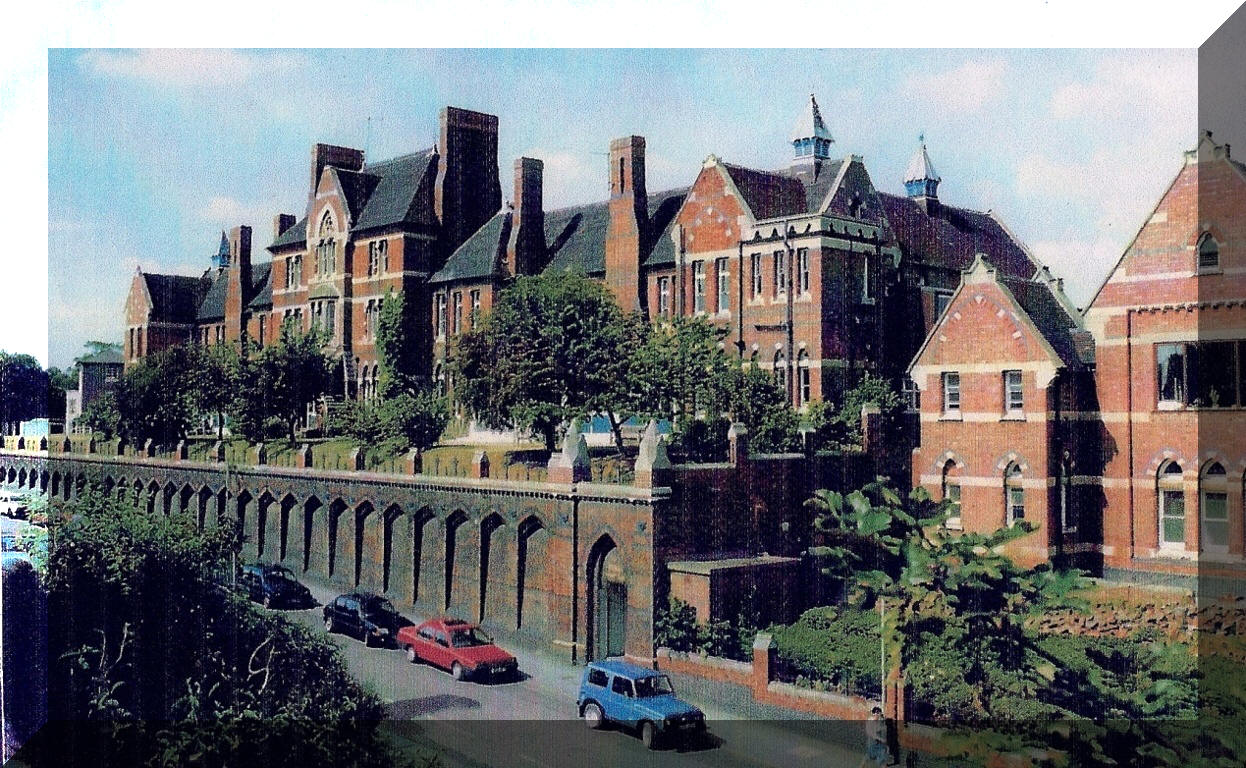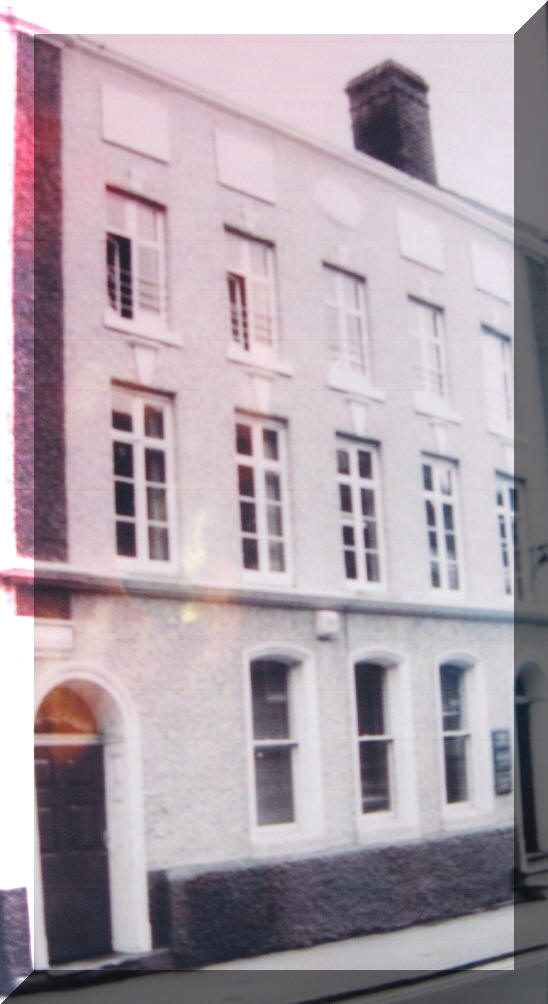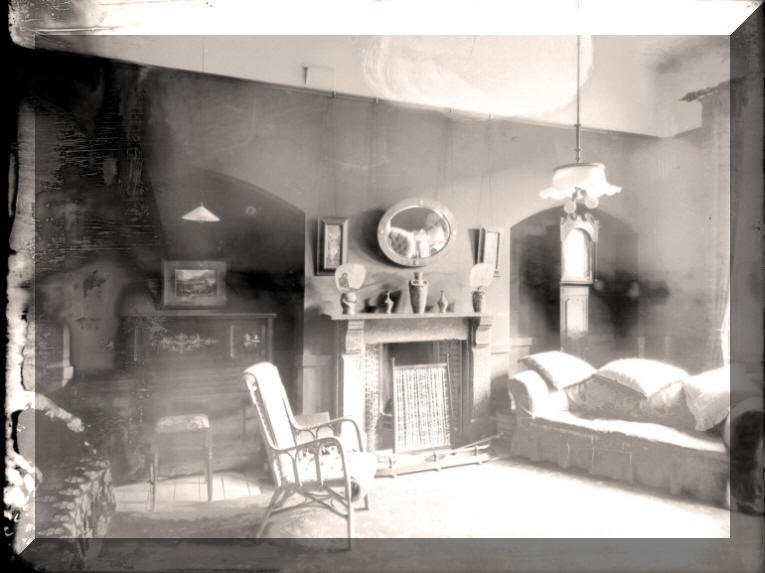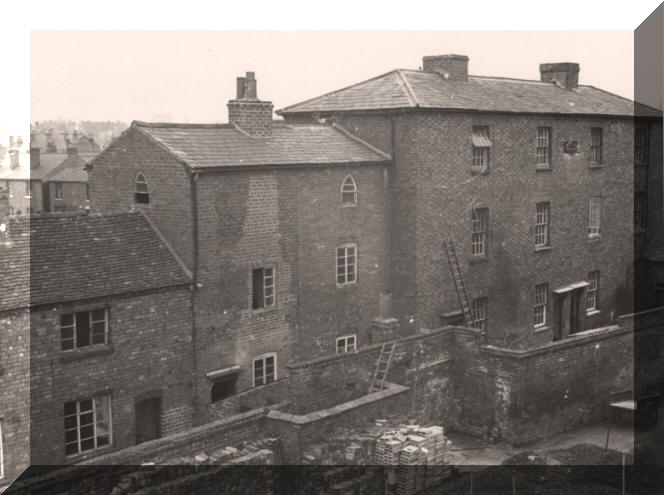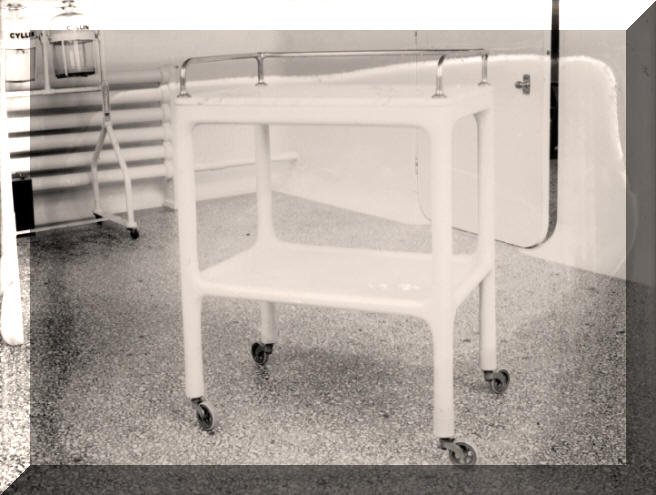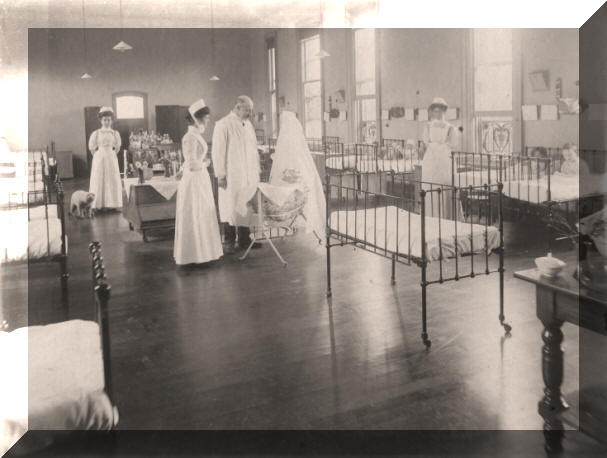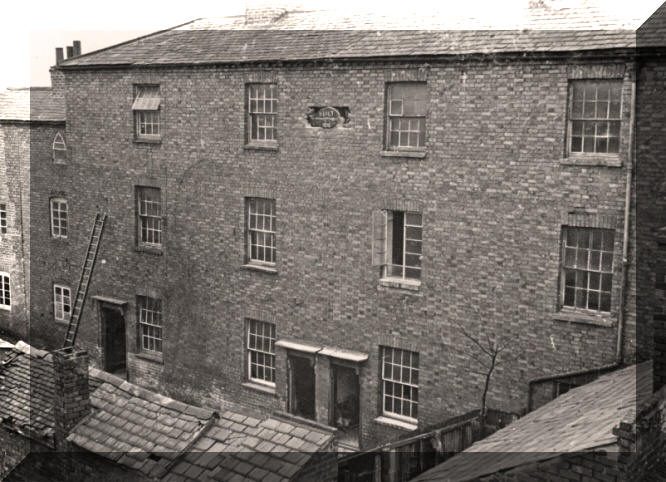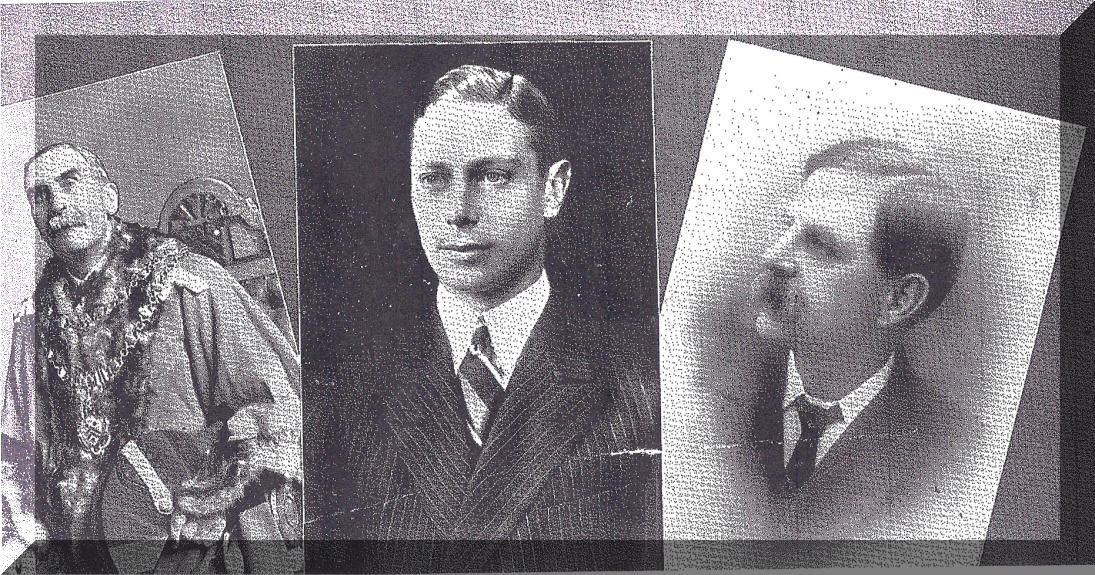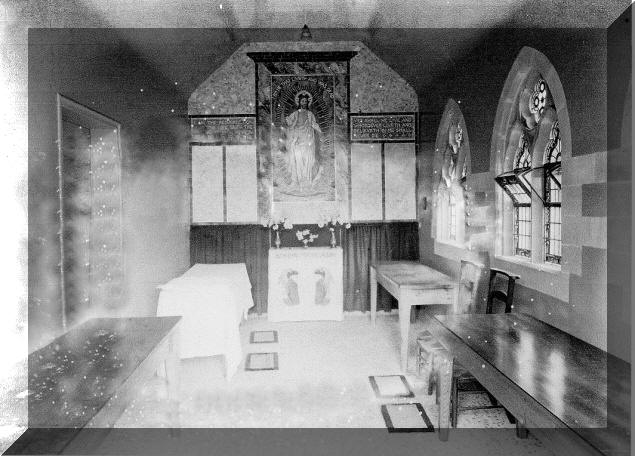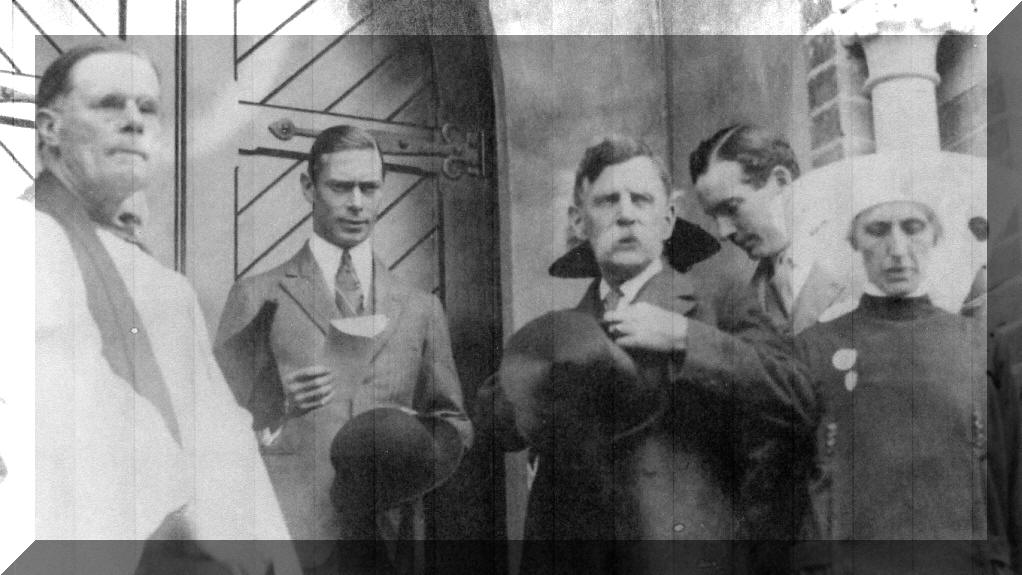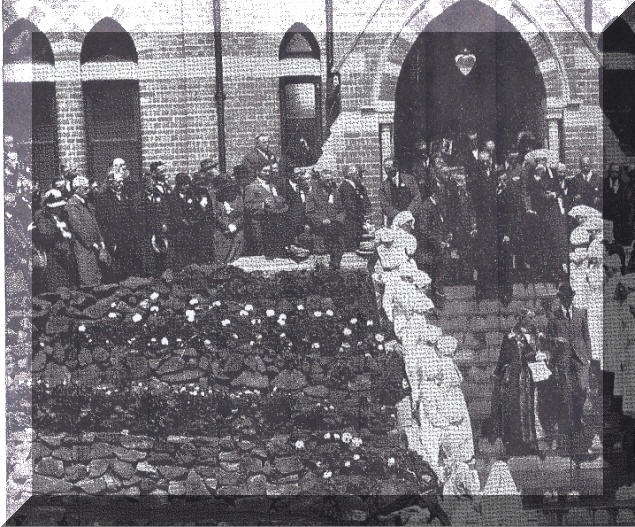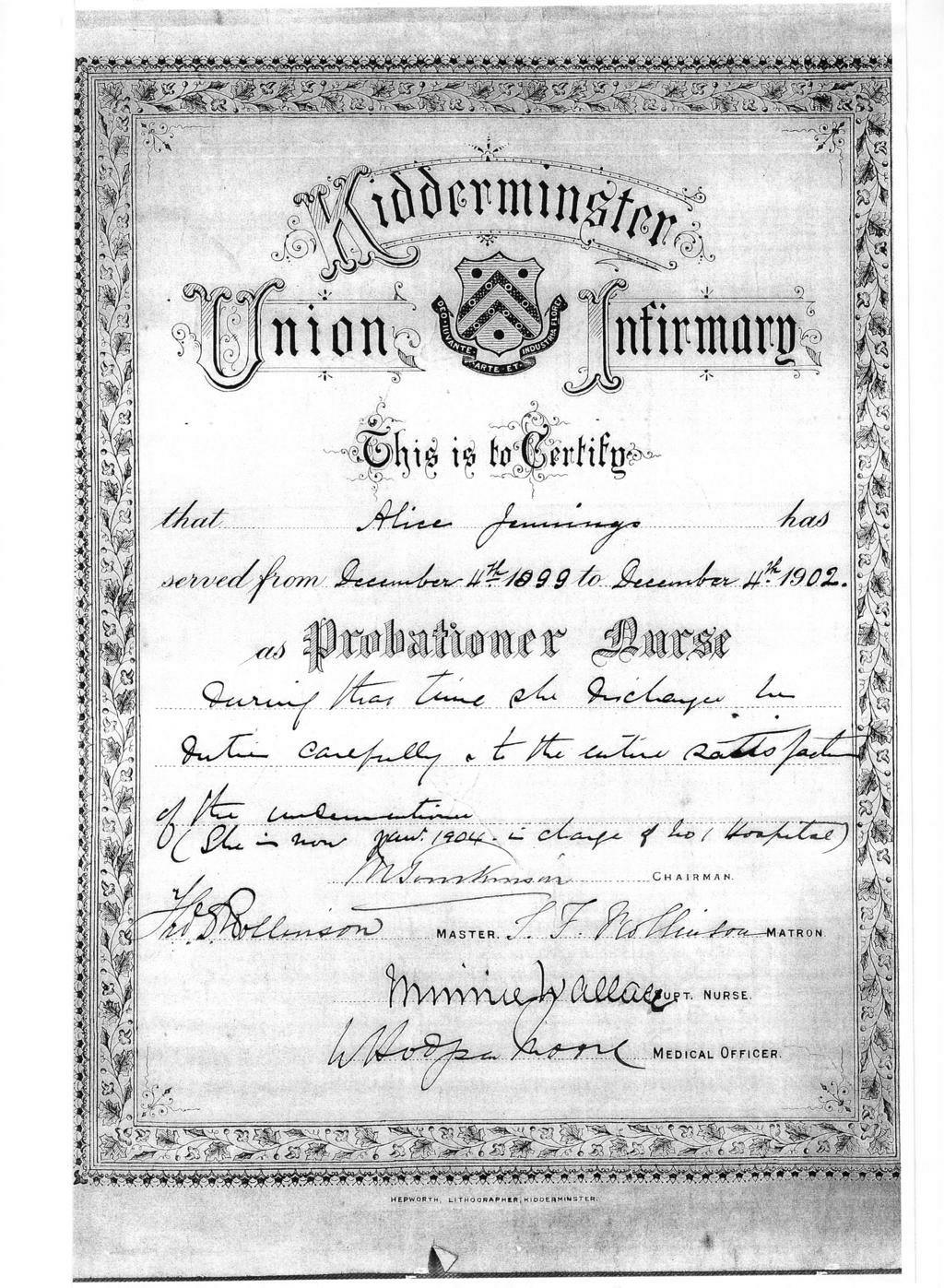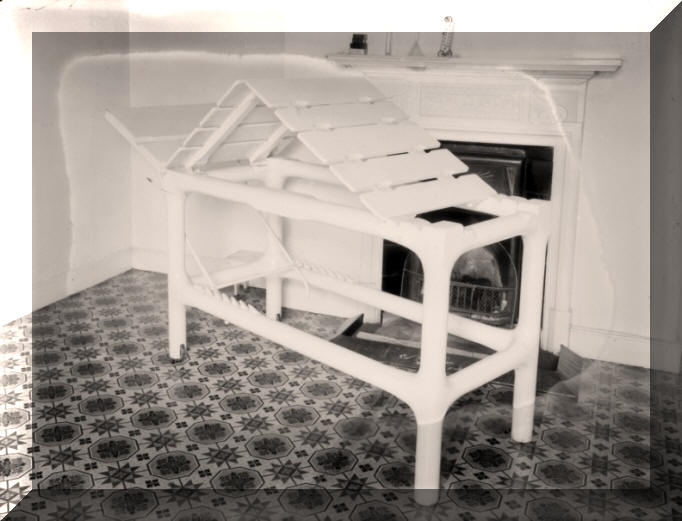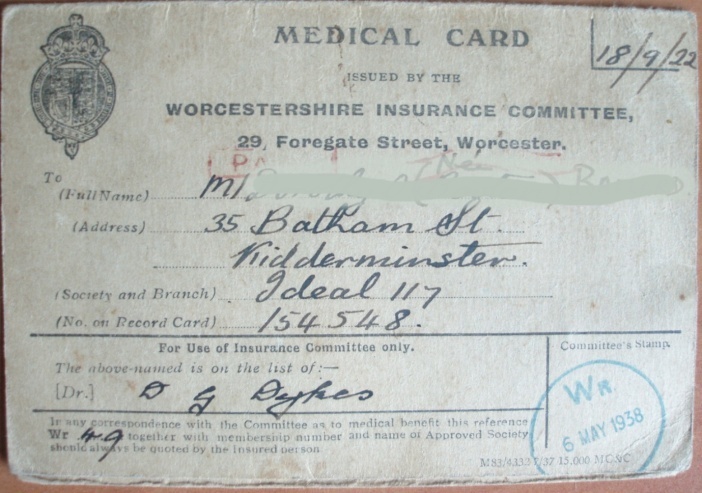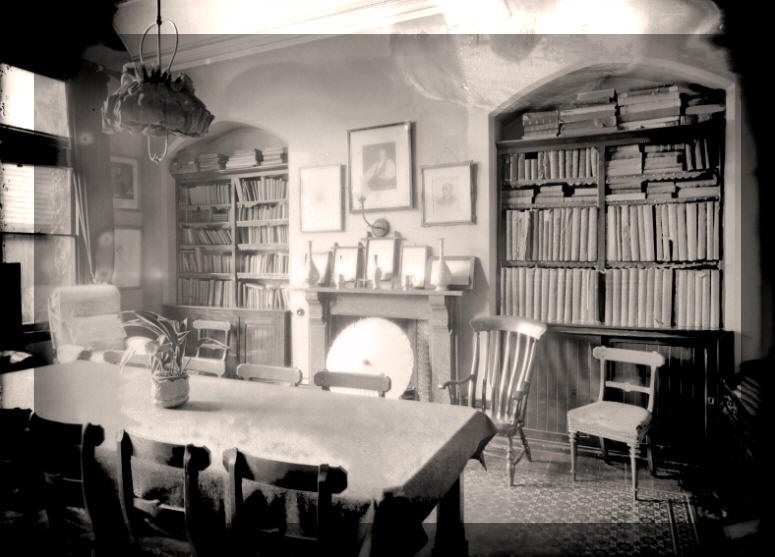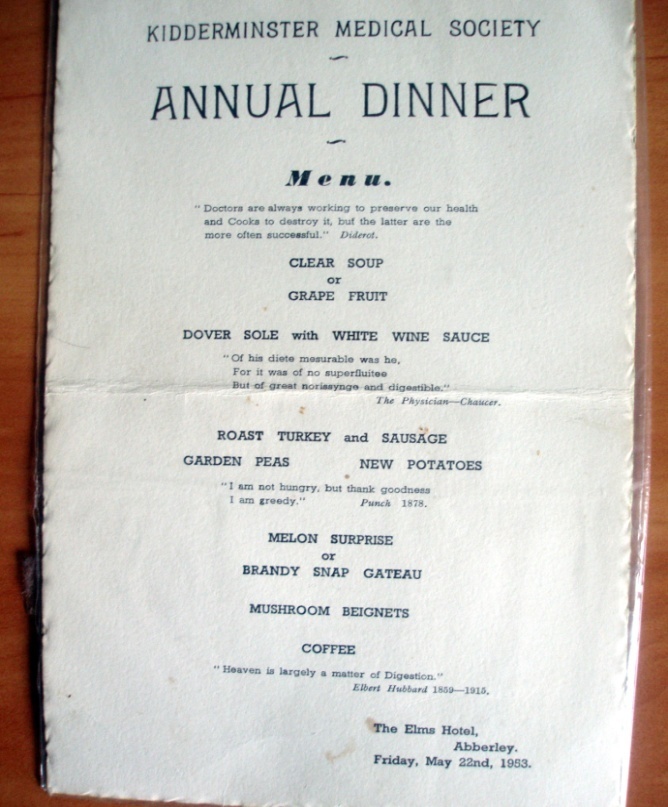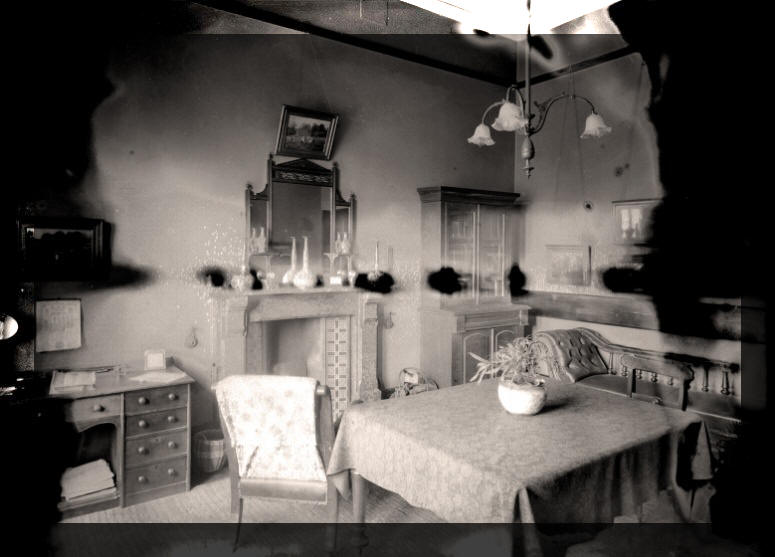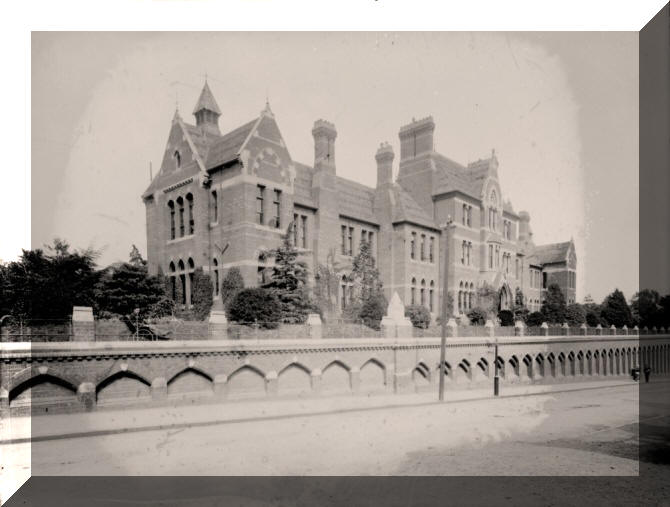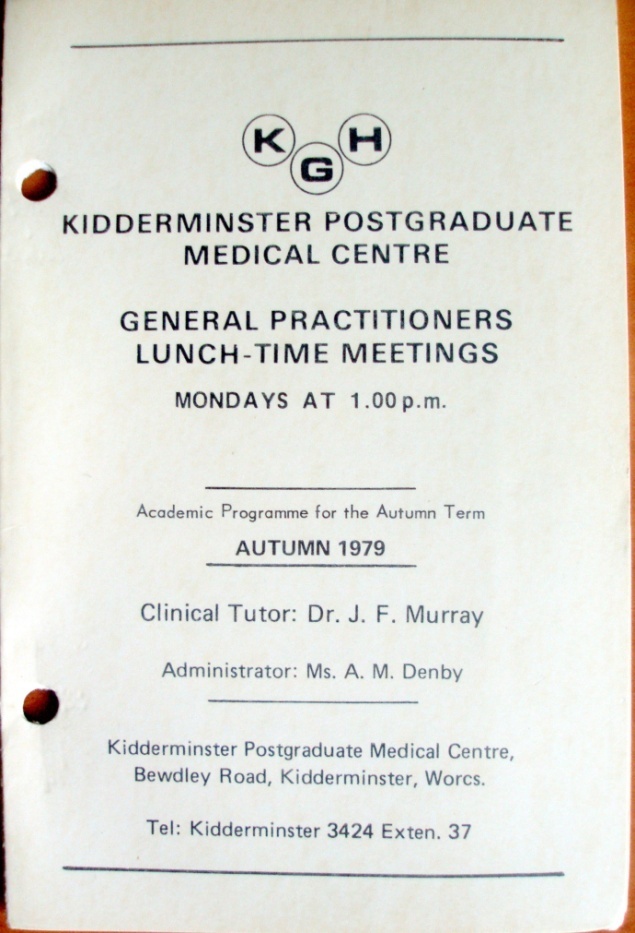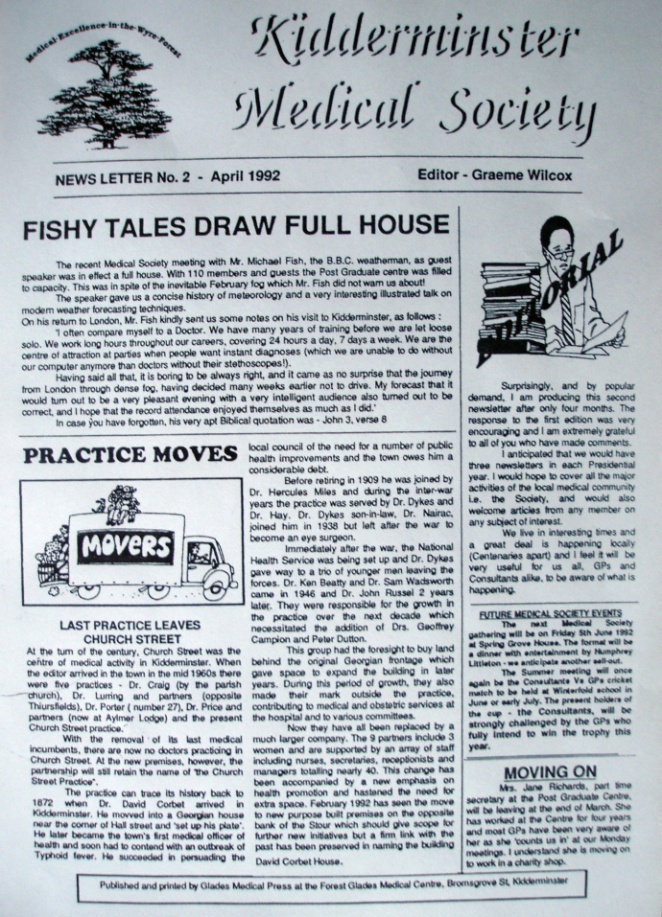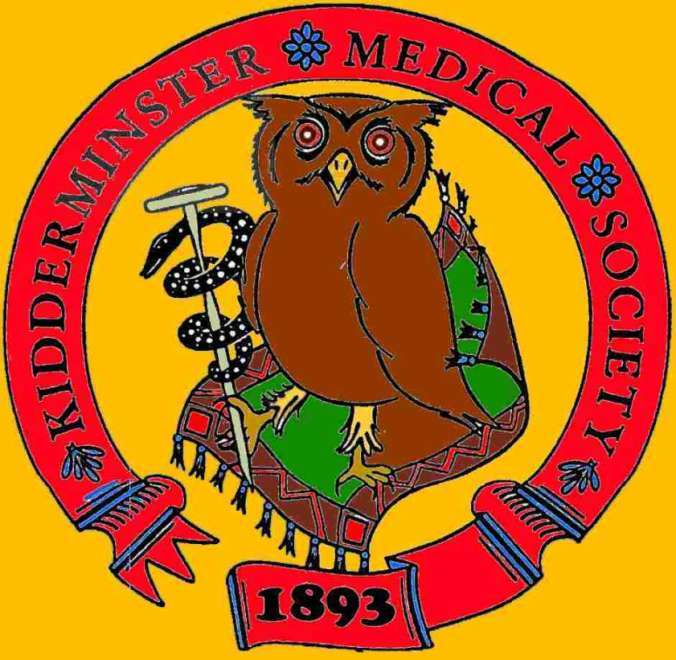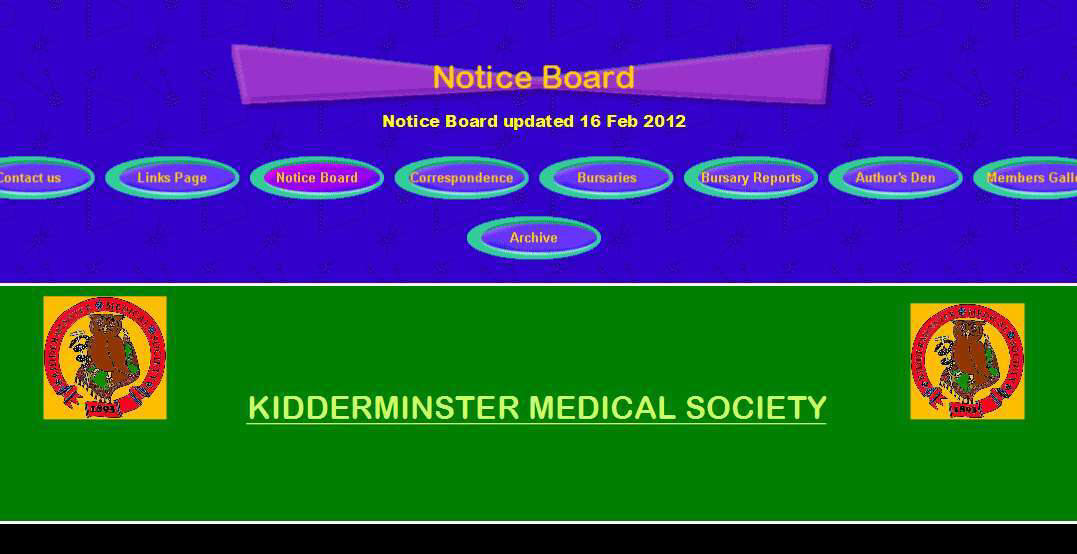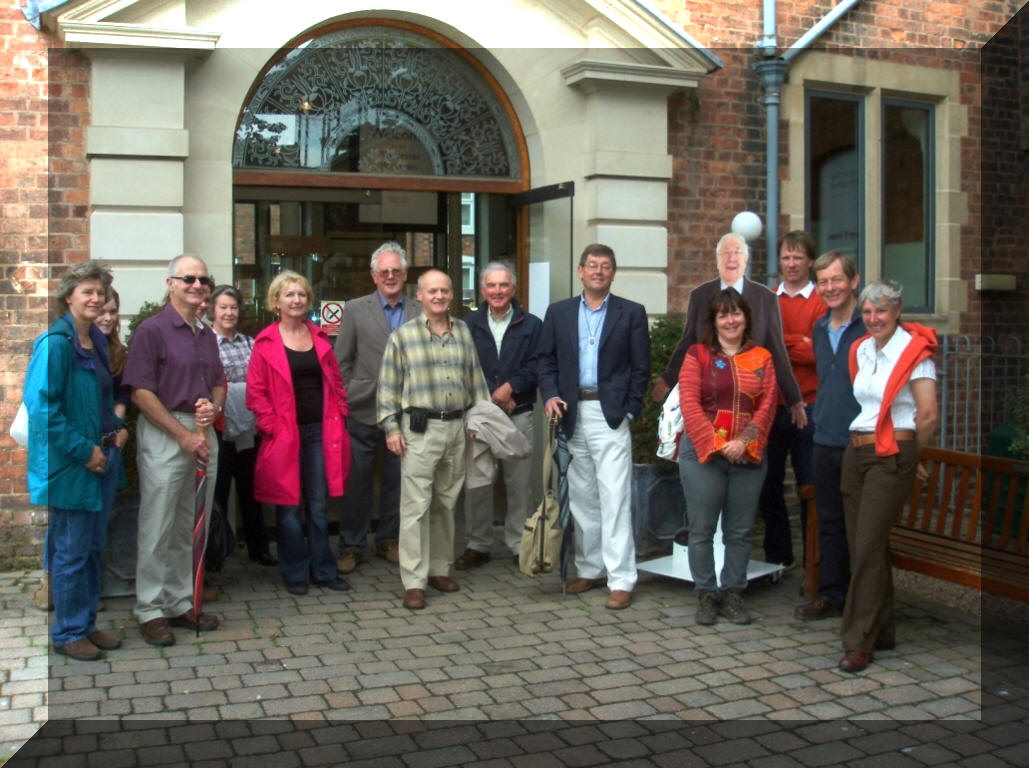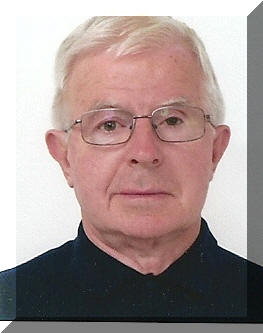.jpg) The History of Kidderminster
Medical Society
The History of Kidderminster
Medical Society
.jpg)
Dr John Murray

|
Kidderminster Medical Society
At eight o’clock on October 19th 1893 a group of medical men presented themselves at the door of number 27 Church Street, Kidderminster, the home of Mr John Lionel Stretton who was known by his second name. They had been invited by his father Mr Samuel Stretton a well known local surgeon. Samuel was the chairman at the consequent meeting at which his son (John) Lionel proposed a motion “That it is desirable to form a medical society for Kidderminster and District”. Mr Walter Moore of Stourport seconded the motion which appears to have been carried nem con by the 13 doctors present. Lionel Stretton then presented a well written set of rules which was adopted after discussion. A programme was proposed for regular meetings commencing with an initial Conversatzione to be addressed by Mr O Pemberton, to which local dignitaries were to be invited.
|
|
|
The rules submitted by Mr J Lionel Stretton were adopted. They were as follows:- 1. That the Society be entitled the Kidderminster Medical Society. 2. That the object of the Society be to discuss matters of professional interest. 3. That any registered medical practitioner be eligible for membership. 4. That members may be proposed and seconded at any meeting, and shall be balloted for at the following meeting. One black ball in four to exclude. 5. That visitors may be introduced subject to the approval of the Chairman, enjoying the same privileges as a member in debate. 6. That no visitors resident within five miles be introduced more than once. 7. That the subscription be five shillings a year payable in advance, & that any member omitting to pay his subscription shall, after due notice from the Secretary, cease to belong to the Society. 8. That the Officers shall consist 0f a President, two Vice Presidents & a Secretary, who shall form a Committee of Management. 9. That the Officers shall be elected at the Annual Meeting & shall be eligible for re-election. 10. That the Annual Meeting be held on the first Friday of October each year, at 4.00 pm. When the retiring president shall deliver an address and the balance sheet shall be submitted. 11. That there be at least one meeting per quarter, of which due notice be given to each member a fortnight previously, with a note of matters to be brought forward. 12.That a special meeting may be called at any time by four members providing that at least 21 days notice be given the Secretary, and the purpose of the meeting distinctly stated in writing. 13. That notice of papers be handed in at the Annual Meeting & at such meeting dates be fixed for them to be read. 14. That members shall give 21 days notice of any communication they desire to make at the next meeting. 15. That meetings be held in the Committee Room of the Kidderminster Infirmary or such a place as may be subsequently decided upon. 16. That the hours be from 8.00pm to 10.00pm. Tea and coffee to be provided at 10.00pm. 17. That length of a meeting may be prolonged, or the meeting adjourned with the consent of two thirds of the members present. 18. That a quorum shall consist of five members. 19. That the ordinary rules of debate shall be observed 20. That in the absence of the President the chair be taken by one of the Vice Presidents or the Secretary, & failing them the meeting to elect its own Chairman. 21. The members may exhibit any cases or specimens after the minutes of the last meeting have been confirmed, provided the reading be not commenced later than 8.45pm and, when possible, notice of these cases or specimens shall be given. 22. That the length of a paper or communication shall not exceed 30 minutes. 23. That no member shall occupy more than 10 minutes in the discussion following any communication or paper. 24. That the Chairman shall have the option of permitting members to bring forward items not notified on the agenda. 25. That at the termination of each meeting the subject of the next paper shall be announced by the Secretary. 26 That no rules can be altered & no new rule added unless passed at one meeting & confirmed by a second, due notice having been given beforehand
|
|
|
26 /
27 Church Street, Home of Lionel Stretton |
In 1893 Kidderminster was a busy and somewhat squalid industrial town. Earlier most of the commercial activity had centred on the wharves below St Mary’s Church although the railway had taken much of the trade away from the canal in 1893. The years leading up to 1893 had been hard especially for carpet manufacture owing to the introduction elsewhere of American Axminster looms which unlike the Brussels looms, could be operated by women. Several large firms went bankrupt. Brintons developed their own Jaquard loom and survived. Church Street where Lionel Stretton lived, owning nos. 26 and 27, appears today to have always been a residential street with office buildings interspersed amongst the houses. This was far from true in 1893. There were factories on both sides of the street ranging from carpet works to metal foundries. Horses would have dominated traffic and stabling was widely available behind buildings on the streets. There was much poor housing in ‘courts’ with small buildings packed together. In addition there were middens, pig sties and wells in close proximity to dwellings. Sanitary conditions were still poor despite the very late arrival of public sewage in 1874. The sewers and water supply installed were inadequate and badly constructed. Epidemics persisted for many years. A new reservoir at a higher level was built in 1886 and water closets were encouraged. As to the world in general the Queen Empress Victoria ruled a huge empire but the United States was already the largest industrial power and was engaged in the Spanish American war. At this point it is appropriate to consider the reasons for the founding of the society. Firstly there was the pursuit of knowledge in a rapidly changing subject especially where surgery was concerned. The discovery of ‘germs’ by Pasteur and their role in infection plus the introduction of General Anaesthesia led to enormous advances in surgery. By contrast there were few effective drugs, particularly to combat infection. A second factor, of which one quickly becomes aware on reading the minutes, is a trade union function particularly in relation to Medical Aid Societies. These existed to provide basic medical care for poor families. They paid practitioners a sum per annum but this was often considered too small. Doctors employed in a supervisory role by medical aid societies were also subject to criticism by their colleagues.
|
| The 22 Original Members of KMS
Samuel C Stretton
Signed 19 / 12 / 1893 by Samuel Stretton |
At the inception of the Society we find a statement signed by 23 doctors condemning the Kidderminster Medical Aid Society on the page opposite the account of the Society’s first meeting. It is undated. There are many subsequent references to the local medical aid societies. The economic troubles of the town, particularly those of the carpet industry, must have affected medical practitioners as much as other citizens and this may have had some bearing on their actions. A third function was a social one. As the Society gained in number so the range of social events increased although they were confined to the local area From the outset the Society required its members to be registered practitioners. The Medical Act of 1858 had finally put an end to unlicensed practitioners and had created the General Medical Council to keep a list of those eligible to practise. From that time medical education was confined to recognised institutions and medical students received a grounding in basic sciences before proceeding to clinical training. All of the original members had a qualification recognised by the GMC and had followed a course of recognised training at a teaching hospital. Some, like Samuel Stretton, had undergone part of their training under the old apprentice system. In the early minutes most of the members kept the title Mr. rather than calling themselves Doctor, but by 1900 this had changed and only the honorary surgeons used the title Mr. Later registered dental practitioners were admitted to the society and members were advised to refer patients only to registered dentists. Unqualified dentists continued to practise until the 1920s. |
|
1894 Held on 23rd February 1894 the first meeting of the Society was in two parts. At 4.30pm, with Mr JL Stretton in the chair, it was explained that it had proved impossible to find a speaker for the main meeting and Mr Stretton would give the address. He proposed a monogram for the society ”omnes sapientes declet et conferre et fabulare”– ‘It becomes all wise men to gather together and converse’.
At 8.00pm Mr Stretton addressed the members and invited guests (numbering 17) on the subject of health in the town, contrasting the current conditions with that obtaining 25 years before. A vote of thanks to the speaker was proposed by the meeting and Mr John Brinton seconded by Mr Herbert Smith proposed “Success to the Kidderminster Medical Society”. Both of these men figured prominently in the subsequent history of Kidderminster. Dr Corbet agreed to obtain designs for a Society Shield or Monogram. |
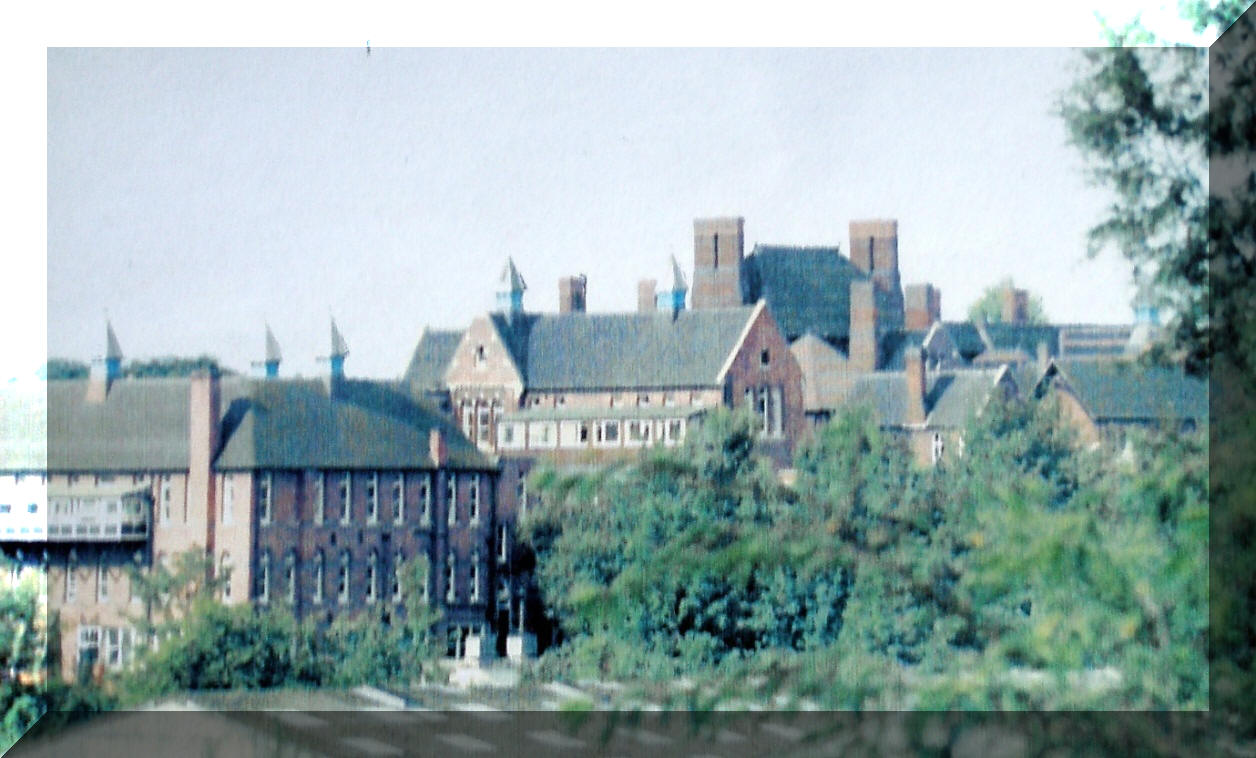 |
|
The Monogram had failed to arrive by the March meeting but Dr Corbet promised to have some designs for the next meeting. Case presentations followed including tuberculosis of the spine mistaken for a kidney infection, removal of the femoral epiphysis, and an enchondroma of the jaw. Mr JL Stretton gave a talk on modern methods of amputation. A busy evening ended with discussion of a letter from a Dr Martin who was employed by the Stourport Medical Aid Association and who had made a major effort to resolve problems between the doctors and the Aid Associations. The protracted discussion was to be continued at the next meeting. Dr Martin’s name appears on a number of occasions. He seems to have been an honourable, well meaning, well trained man (he had an MD) who was trying to reach a fair compromise. He was clearly exasperated by entrenched views on both sides. The format was retained for the remaining four meetings in 1894. After the usual reading of previous minutes Mr JL Stretton opened proceedings by presenting a series of cases he had operated on. Their variety and severity would test most modern doctors. As an example a patient died after an operation for ectopic pregnancy despite the intravenous infusion of three pints of saline, very small by modern standards, but advanced for the time. Another death during an operation for strangulated hernia was attributed to chloroform. The patient, a publican, was very frightened (he was brought to the hospital in Mr Stretton’s carriage) and could not be anaesthetised with ether hence the initial use of the less irritant but more dangerous chloroform which accounted for his death. In November Mr Moore read a paper on Medical Aid Societies. Whilst accepting their having some good points he maintained they had harmed the profession, a view he expressed at subsequent meetings. Nonetheless the meeting would not support a proposal for collective action against the Medical Aid Societies and clubs. Disagreements amongst doctors were not unknown. Dr Robinson declared that Mr Stretton had operated on his patient without informing him. New Officers were elected in September; Dr David Corbet was to be President and Drs Addenbrooke and Fitch, Vice Presidents. Dr Corbet was a respected figure who later became Medical Officer of Health and did a great deal to improve the health of the townsfolk. 1895 proved to a fallow year. The first meeting under Dr Corbet’s presidency was attended by only six members. One of the presentations was of a man who fell from a tree sustaining a compound fracture of the femur and suspected fractures of the scapula and humerus (there were no X-rays). It speaks for the toughness of the times that he returned to work using a crutch! An unusual case was described. A bricklayer working on a retort died and his death was ascribed to “carbonic acid poisoning”. From the description it was clearly carbon monoxide poisoning which the Victorians called carbonic acid. There was a problem in getting sufficient members. There were only 27 doctors in Kidderminster and adjacent centres and this limited the scope of meetings and the ability to attract good speakers. The matter of clubs and Medical Aid Societies came up again. The original motion against Aid Associations was maintained and those taking positions with clubs were condemned. An attempt was to be made to obtain four shillings per annum per patient from clubs and other organisations. Support was obtained from the Hereford and Worcester branches of the BMA. One finds this incongruous now and I feel it represents a response to difficult times. |
|
|
|
From the first meeting the Stretton family played a major role in the Society. Samuel Stretton was very well known in the area. He and his family had done a great deal to have the new Kidderminster Infirmary built in 1870-71 He was the honorary surgeon to the hospital as were his son Lionel and his grandson John at a later period. His initial training had been under the old system as an apprentice to a local surgeon and he had subsequently attended St Bartholomew’s Hospital where he had obtained MRCS in 1854. A House Surgeons post at St Bartholomew’s followed and he subsequently went as a civilian surgeon to the Crimea, after a period of surgical training in a group which included Sir Thomas Spencer Wells. He would appear to have worked at Scutari but one authority states that he was also at the prefabricated hospital designed in six weeks by Isambard Kingdom Brunel. One understands that mortality figures were markedly better than at Scutari, Florence Nightingale’s hospital. He passed the LSA in 1856 and then settled in Kidderminster Lionel Stretton trained at St Bartholomew’s Hospital with W G Grace. He obtained honours in Anatomy, Surgery and Physiology and qualified MRCS Lond., LRCP Lond and LSA. He was Assistant Chloroformist at Barts which would explain his writing a book on anaesthesia later. In 1882 at the age of 22 he joined his father’s practice and having concentrated on surgical practice became surgeon to the Infirmary. He seems to have been both competent and confident. Dr Usher Miles who was his anaesthetist wrote in his obituary “he was a man of tireless energy, who never got flurried in any emergency, and who was always considerate to his assistants and nurses.” He was noted for having suggested iodine for preoperative skin sterilisation. Lionel Stretton hardly missed a meeting of the Medical Society from the first in 1893 to 1942. The family raised much of the money for the Infirmary (later Hospital) and supported many other causes in Kidderminster. |
|
1896 In February a case history was presented of an Italian girl who underwent a Caesarean section after the baby had undergone a craniotomy! It is no surprise that she died after such trauma. Later a number of cases of tracheostomy, presumably for Diphtheria, were presented, some (or most) performed at home. A modern doctor would have been hard put to cope. At the Annual General meeting Dr Moore from Stourport was elected President for the coming year. 1897 The year commenced with a renewal of arguments with the Stourport Medical Aid Society. Dr Martin was interviewed. At the January meeting the Society was read Dr Martin’s reply which was forthright in stating that his accusers, apparently Drs Moore and Robinson, were guilty of the very faults they ascribed to him, namely “buying patients and canvassing”. The usual vigorous discussion ensued. The Aid Societies also made clear they could not limit entry to those earning below a certain income. The Society heard a discourse on General Practice by Samuel Stretton. He was gloomy about prospects and felt there were too many practitioners. On the positive side the Society bought a few books to start a medical library. The May meeting heard Lionel Stretton describe a successful Cholecystenterostomy. He then gave a talk on Anaesthesia (he had been chloroformist to St Bartholomew’s Hospital) in which he advocated ether in preference to chloroform. A Clover’s inhaler was advised for ether but lint only for chloroform. Other essentials included tongue forceps, a tracheotomy tube and a hypodermic syringe. The identity of the anaesthetist is not mentioned in the case presentations but when one considers the grave state of many patients undergoing operation he must have been extremely competent. At the AGM followed by the Annual Dinner, Samuel Stretton was elected President for following the year. He would have been 56 years old and does not seem to have made any case presentations to the Society. In November Lionel Stretton described a repair of nerves and tendons of the wrist with, remarkably, some recovery of function. 1898 In January Lionel Stretton also described enlargement of the prostate in a young man (who denied masturbation!) Treatment was equally unusual being thyroid tablets! The advance of science can be gauged from an account of septicaemia successfully treated with serum from the Institute Pasteur and the sending of specimens of an ovarian tumour to the Clinical Research Association which declared it benign. 1899 Dr E. Addenbrooke was President in 1899. There were three meetings but activity was reduced, possibly because of an outbreak of influenza in March. At the January meeting a skiagram (X-ray) of a fracture was shown and Lionel Stretton gave a talk on tuberculosis. Treatment of TB with creosote was described at the March meeting apparently with success! The AGM was held at the Lion Hotel in October. After the dinner it was decided to send a delegate to the Manchester Guild Meeting. Three guineas were allocated for his expenses. The subscription to Lewis’s Library was continued. In November Lionel Stretton described a laparotomy which disclosed pus around the caecum. A colostomy was performed with a good result. There were of course no colostomy bags available at that time. The December meeting ended the year. Dr Evans presented a case in which a head injury was followed by “turns”. Craniotomy disclosed a bone fragment which must have pressed on the brain. Removal cured her symptoms. Lionel Stretton showed a repair of a patellar fracture with silver wire. This procedure is used today. Presumably because of the lack of new members a proposal was made for amalgamation with other Societies. The BMA would remain as the primary organisation. No decision was taken. |
|
|
Presidents KMS 1893-1950
1893 Samuel
Stretton
|
1900 – A new Millennium Numbers had increased little in the seven years since the Society was founded and this limited the ability to attract outside speakers so that the original format of case presentations, often by Lionel Stretton, and topics worked up by other members, made up the intellectual fare. As a result the emphasis was on Surgery rather than Medicine but there was in reality much more progress in the former speciality. New operations abounded but there were few effective drugs other than morphine, digoxin and neoarsphenamine. The Boer war was in progress but an easy victory was foreseen. This view was soon shown to be mistaken as the Boers proved masters of guerrilla warfare. The economy of the town cannot have been buoyant since, despite a high birth rate, the population had remained at 21,000 from 1881 to 1901 whilst increasing in the country as a whole. Many workers had apparently emigrated. Women employees outnumbered men in the carpet factories reflecting a preference for Axminster over the heavier Brussels carpet. Doctors must have suffered financially with the rest of the population and this may explain the rancour towards Medical Aid Societies which they considered to be limiting their earnings. The Medical Society had gained few members since its inception and one or two such as Barclay Murray of Cleobury resigned because of the time taken to travel to Kidderminster. The journey would have taken about two hours by horse drawn transport. Lionel Stretton was again President in 1900 but numbers at meetings were reduced. Eleven members were present in March but there had been a severe outbreak of influenza. In May Dr Addenbrooke reported on the Manchester Medical Society meeting and its conclusions. These included 1) Opposition to the registration of midwives. The principal reason advanced for this stance was that established but untrained midwives would suffer. The argument seems at odds with the need to improve patient care and with hindsight the attitude was mistaken. A pecuniary motive was not lacking – a doctor called to a delivery by a midwife got no fee! 2) Support for a maximum wage limit for those entering Friendly (and Medical) Societies. This was a constant problem locally. 3) The BMA to become the main representative body for doctors. 4) One Guinea to be demanded for certifying lunacy patients. At the AGM in October Mr JL Stretton was again elected President. At the November meeting he described a truly heroic operation for the time, namely the removal of the upper lobe of the left lung for tuberculosis. The patient survived after drainage of sepsis and expectoration ceased. At no time was the anaesthetist mentioned! A child of 24 months died after failure to reduce an intussusception. Dr Martin had had several meetings with the Society on the vexed questions of canvassing, collection of medical Aid Society fees etc. He appears to have eliminated most abuses but not to have been forgiven |
|
1901 Another momentous event! Queen Victoria died. At the first meeting of the year there was a minutes silence and the hope was expressed that the new king Edward would maintain the same standards as his mother. A new member Dr E A Naylor was proposed and accepted. Lionel Stretton then presented three cases of bowel resection following prolonged obstruction. Despite transient improvement following the operation two died. Post mortems performed by a Dr Murray failed to show much peritonitis. One patient was given a saline infusion but it was obviously inadequate. On February 5th a meeting was held with the Stourport Medical Aid Association. An action against the long suffering Dr Martin was suspended. At the March 29th meeting Mr JL Stretton was nominated to be the local representative at the BMA Birmingham meeting. One can see that the profession had decided to rally round the BMA as its main representative generally and in negotiation with the government. Lionel Stretton then presented a case of peritonitis treated by appendicectomy with a good result. A special meeting was called on May 28th to oppose the use of unqualified assistants by dental surgeons. The AGM took place on October 12th. Surprisingly Dr Martin was proposed for membership and accepted. One wonders if he received a warm welcome from the members after the previous disagreements. He was not a regular attender. At November’s meeting Lionel Stretton described resection of the colon for carcinoma with a two year history. The patient died. A breast tumour was found by the Clinical Research Association to be benign but there was a malignant recurrence. The appearance of this body which appears to have been an independent Pathology laboratory shows how quickly scientific medicine was progressing. A last case was the death of a horse under chloroform. Ether could not have been given to such a powerful animal and the death followed the usual pattern seen in humans of sudden cyanosis probably from ventricular fibrillation. |
|
|
|
1902 The meetings followed the pattern of business which was often related to money, after which came a lecture or case presentation, often by Lionel Stretton. At the February meeting he described removal of a hip and an elbow joint for tuberculosis. Both patients returned to work! A young woman with cancrum oris was treated by it’s being split and cauterised with little disfigurement. This condition, hardly ever seen these days, is mentioned on several occasions. Clay pipe smoking may have been a causative factor. At the April meeting tetanus arising in a boil on the neck led to the death of a young boy. The pros and cons of vaccination were discussed. A special meeting was called in May to discuss the employment of an unqualified anaesthetist by a dental surgeon. A firm letter demanding that it not be repeated was sent to the offender. On October 17th The AGM and dinner took place at the Black Horn Hotel, a new venue. Dental surgeons requested eligibility for membership. A long discussion was to be continued at the next meeting. They were made eligible. Mr Stretton in his presentation reminded members that appendicectomy which was barely known 20 years beforehand was now performed frequently. A textbook, Dr Clifford Albutts System of Medicine, was to be acquired. The first death amongst members, that of Mr J Webster, was announced at Novembers meeting. Mr Stretton showed 40 gallstones removed from a 50 year old woman. A fractured patella had been repaired with silver wire and a tuberculous ulcer of the knee was treated with X-rays. A Special meeting was arranged on December 12th. The principal matter was the admission of Dental Surgeons. This was agreed. Mr Stretton read an article from the BMJ on the Medical Compensation act and the payment for certificates. The article was to be circulated to all members. A discussion on school board certificates followed. It was made clear that completion of the forms was not mandatory. A fee of one shilling was proposed and carried. Dr Corbet read advice on the care of children from the Council. Items included the changing of soiled nappies and the use of boiled cows milk if the mother’s milk was inadequate. |
|
1903 Mr J Lionel Stretton was again President. It was the tenth anniversary of the society and numbers remained about the same He showed cases of appendicectomy for TB peritonitis and the treatment of anthrax by instillation of powder. The patients appear to have survived. He advised microscopy to confirm the diagnosis. A man with dyspnoea was given chloroform possibly with a view to tracheotomy and died. An inquest jury found death due to asphyxia under chloroform. In May Dr Addenbrooke described the treatment of rhinitis with cocaine! Time and again one finds ad hoc remedies being applied which would horrify a modern doctor. Drugs were administered without proper evaluation and double blind trials were unheard of. A Special meeting was held with the Kidderminster Medical Association and the medical Aid Association. A no canvassing agreement was reached as was a wage limit to be applied to membership of the aid associations. Dr Martin was relieved of all the” disabilities applied to him” including that banning him from the Medical Society. At the Annual General Meeting in November Dr WH Moore was elected President for 1904. Only eight members and two visitors were present which must indicate some apathy. 1904 At the February meeting JL Stretton showed a case in which a trephine showed that an abscess of the middle ear had drained through the brain to a hole in the skull. In March the Midwives Act 1902 was discussed. Some doctors objected to untrained and ignorant women being allowed on to the register. Mr Stretton described some remarkable cases:- -Retropubic prostatectomy, an operation one associates with the mid 20th century. The patient was 83! -Removal of the Gasserian ganglion from within the cranium by Hartlings (Hartels?) method! The reason for this extraordinary procedure is not given. -Removal of a large retrosternal mass after tracheostomy. The tumour regrew and the patient died a month later. -The dangers of chloroform were again shown when a child died following an operation on a terminal phalanx. Dr Brocket showed skiagrams (x-rays), evidencing the growing impact of science on medical practice. The Society had reached its 10th year. Unlike it’s precursor at Worcester, which became the BMA, it had failed to grow and numbers were little changed from its beginning. The May meeting was of medico-legal interest. Dr Martin showed a defamatory letter from a clergyman. He was referred to the Medical Defence Union who subsequently obliged the clergyman to sign a dictated apology and pay £25 – quite a significant sum. Mr Hodgson Moore vacated the presidential chair to contest with Mr Robinson a case which he had attended during the latter’s illness. The patient’s husband had called Mr Moore by telephone to say she was gravely ill and a letter confirmed this. Rather than subject the Society to open contention it was decided to form an ethics sub-committee which would institute guidelines. In June a Special meeting heard visiting speaker, Dr Lipp, read a paper on Anthrax. He had seen 211 cases in five years of which 26 were fatal. Head and neck infections had the highest fatality. A report on a serum prepared by Professor Sclaro from Italy by JL Stretton declared it to be totally effective and totally safe! Once again there had been no proper trial of the agent. The 11th AGM on October 14th elected Dr Fitch of Chaddesley Corbett President. 15 members were present and four visitors appeared. At the December meeting numbers were down to eight. In addition to Jl Stretton’s cases of a massive bladder stone, 15 cases of appendicectomy and resection of a tumour of the sigmoid colon both Dr Evans presented cases. The former had performed a repair of umbilical hernia in a child of six months and the latter had removed a uterus containing a sloughing fibroid. All had recovered well. The ethics subcommittee proposed the adoption of the rules of the Manchester Medical Ethics Society. They related to medical etiquette as regards courtesy, accepting other doctors’ patients and the charging of fees (or not charging doctors and their families). They were accepted and it was decided to have them printed. |
|
|
1905 In 1905 Mr Fitch was president. One or two visitors from the previous year had joined the Society e.g. Dr Dykes. For the first meeting in February JL Stretton took the chair. Nine members were present. He presented a number of cases including anthrax treated with Prof. Sclaro’s serum and excision, and a patellar fracture repaired with silver wire, a procedure like those performed today. The silver would have been self sterilising. A Mr Oldham who appears to have been an ordinary visitor discussed peripheral neuritis in pregnancy. The rules of the Manchester Medical Ethics Society were read out. Many refer to associating with unqualified practitioners and activities such as advertising and canvassing. Treating another practitioner's patients without that practitioner’s agreement was a major misdemeanour. There were exceptions but quite often no fee was to be charged if the patient had another practitioner. A final point was that other practitioners and their families were to be treated free. In March Mr Stretton gave a talk on sepsis and asepsis which included the proper sterilisation of equipment, preventing collections of blood, and the use of iodoform. The use of the latter was criticised by Dr B Addenbrooke but it was probably a useful agent, indeed a letter in the BMJ at a later date gives credit to Jl Stretton for introducing the use of iodine. The admission of dental surgeons to appropriate meetings was agreed. At the May meeting Dr Fitch was in the chair. Dr Foote was elected member, one of a steady flow of doctors joining the Society. JL Stretton again presented cases to astound the modern reader. TB glands weighing about a pound were removed from the necks of two young girls without dividing the sternomastoid muscle. A caesarean section and hysterectomy for a ruptured uterus was successful and another cure of anthrax with Prof Sclaro’s serum was presented. |
|
|
Dr Oliver Evans in Paediatric Ward behind Mill Street |
On October 13th 1905 the AGM and dinner were held at ‘The Black Horse’ and Dr Evans was elected President. Thirteen members and one visitor were present. Dr Evans presided at the first meeting of 1906 on February 9th. Jl Stretton led the case presentation with a description of malignant pustule, an invasive destructive bacterial infection, of the lip treated by excision and Prof Sclaro’s serum. Dr Evans not to be outdone showed a case in which he had excised an epithelioma of the lip. A repair was made using skin from the cheek. A Mr Wilson Smyth presented a case of leukaemia in a 13 month old child. He would appear to have been a microscopist who the next month presented a case of syphilis of the spleen and one of pernicious anaemia. The AGM took place at The Black Horse. Dr Evans and all the officers were re-elected. Complaints had been made about unqualified practitioners, particularly a masseur who had been recommended by prominent medical men in the town. This was condemned.
November 7th saw the last meeting of the year. Mr Stretton had performed thyroid transplantation on a cretin! The final effect was not disclosed. A Mr Johnson of Bewdley suggested the attachment of the society to the Worcester BMA as a subdivision. The Secretary was to examine the case. A Mr Bostock was addressing the Society on unqualified practice but had to stop for lack of time. It was obviously an extensive subject!
|
|
1907 The year commenced with a meeting on February 9th at the Infirmary with Dr Evans in the chair. Six members and one visitor were present. Mr Stretton showed a case of malignant pustule treated by excision and the administration of Sclaro’s serum which has been mentioned previously. The patient survived and had plastic surgery. At the meeting in April the president, Dr Evans and eight others were present but two other doctors, Dr Martin and Dr Trumper, joined as members. Mr Stretton showed a case of cancrum oris successfully treated with Sclaro’s serum. Dr Bertram Addenbrooke related a case of “post influenzal neuritis” causing leg weakness. One presumes the diagnosis would be different today. As regards the proposal from the previous meeting that the Society amalgamate with the BMA, the Secretary, Dr Robinson, proposed that it remain as constituted. This was carried after a heated discussion. The discussion must reflect dissatisfaction with the small numbers at meetings and the consequent lack of good outside speakers. Eight members were present in the Black Horse Hotel for the AGM. Three members had been lost and two gained in that year which emphasised the problems of a small society. Dr E S Robinson was elected President for the following year. On November 15th Dr Robinson was in the chair and 11 members plus two visitors were present. Dr B Addenbrooke showed electric footpads which had been removed from a patient’s house. Mr JL Stretton described post colostomy obstruction thought to be malignant which was relieved by an infusion of violet leaves! He also gave a lecture on cancer including its diagnosis. 1908 Despite the arrival of new members numbers remained small. The increasing importance of public health was evident. A special meeting was held on 8th February to discuss a memorandum from Worcester County Council on the inspection of schoolchildren. It was resolved that no member accept the post of School Inspector for less than the Society’s fee. On 29th May the society heard a lecture from Dr Griffiths from Lincolnshire on actinomycosis, accompanied by slides which must have added to interest in the subject. An ordinary meeting in the Infirmary on May 1st with Dr Robinson in the chair was shown a hydatidiform mole by Dr Fitch and heard the President on “The motor car for medical men”. Most present had a poor opinion of the new contrivance. The surgical competence of other members was highlighted by Dr B Addenbrooke who showed a man who had undergone an operation on a popliteal artery at his hands, and his brother showed a uterus full of fibroids which he had removed. At the 13th AGM which took place on October 16th at the Black Horse Hotel Dr B Addenbrooke was elected President. He presided at the November meeting when a number of cases were shown. In addition a motion of condolence was sent to Mr Stretton on the death of his son. The County Medical Officer of Health had offered one shilling and six pence for school attendance certificates. There was to be consultation with adjacent districts. For the first time a summer meeting was to be held outside the district. The first was to be at Cleobury Mortimer in the following year. 1909 At an ordinary meeting on January 29th Dr E S Robinson took the chair. Mr JL Stretton thanked the Society for their letter of condolence. He then presented two cases of gastro-enterostomy and showed some pathological specimens. In a subsequent talk he advised more gastric surgery. As only two people had replied on the matter of school attendance fees the subject was postponed to the following meeting. The President Dr Addenbrooke was in the chair for the meeting on April 27th but only six members attended. It was decided that the fee for school attendance certificates should be two shillings and sixpence, a considerable sum. Dr O Evans gave a talk on the isolation of cases of scarlet fever. The first ‘away’ meeting was held at Dr Benson’s house in Cleobury Mortimer. After lunch at Dr Bensons, Dr Lockhart-Lowe gave a talk on exophthalmic goitre. The 16th Annual General Meeting took place at the Black Horse Hotel on December 10th. Dr Addenbrooke was in the chair and nine members and one visitor were present. The society had £11 10/8d in its account and it was decided to give two guineas to the testimonial for Miss Barling the retiring Infirmary Matron plus one guinea to the Infirmary debt fund. Mr JL Stretton was elected president for 1910. 1910 commenced with an ordinary meeting on January 28th with Mr Stretton in the chair. Five members and three visitors were present. Mr Stretton presented an elderly man from whom he had removed a lower lid tumour followed by a plastic surgical repair. It had unfortunately recurred and he proposed removal of the maxilla! He also described mechanical repair of several fractures. One was the method of Lucas Champanierres. I have not found a reference to this technique. Other fractures were treated with screws and plates. A further case was a man in whom a secondary sarcoma appeared 17 years after removal of the primary tumour. Dr B Addenbrooke showed a case in which a rodent ulcer of the inner canthus had been treated with radium. An unusual ordinary meeting on March 15th at the Infirmary was attended by 16 members and 60 visitors including Sir Malcolm Morris and Dr Hall Edwards. The former, who had earlier opened the new X-ray Department, gave a lecture entitled “Rontgen rays, Radium and Fusion Light in the Treatment of Disease” This was the society’s largest meeting to date. On April 29th an Ordinary Meeting saw Mr Stretton in the chair with nine others present. Following a discussion the Secretary, Dr Addenbrooke was instructed to write to the BMA regarding non payment of fees to doctors (presumably called by the attending midwife) under the 1909 Midwives Act. Mr Stretton showed a child with thickening of the lower femur. An X-ray (called a skiagram) showed a slipped epiphysis. He also described sterilisation of the skin with iodine in 250 cases. He appears to have been a pioneer in this field. The second summer meeting was held at the home of Walter Moore, Severn House in Stourport. Other than the president there were 10 members and one visitor. It was resolved that doctors be paid one guinea for public health teaching e g nursing and that the fee for ambulance training lectures be the same. The Annual General Meeting was again held at The Black Horse on October 7th. Mr Stretton discussed Ambulance fees in his address. It was decided that the infirmary House Surgeon be elected an honorary member of the Society. Mr Stretton was again elected President. The last meeting of the year was at the request of the Worcester BMA to discuss “Treatment of children found defective”. Items of relevance were attached to the minutes. 1910 finished with the society active but failing to grow partly because the number of doctors in the immediate area was still 23 of whom five were at Tenbury. There was little scope for larger meetings addressed by outside members. A number of dramatic events were in the offing and there is no doubt that the small size of the Society lessened its impact on policy. 1911 The first meeting of the year on January 30th 1911 found Dr Evans in the chair, Mr Stretton being late in arriving. Only four members were present. Mr Stretton showed a fibroid uterus and an ectopic pregnancy which he had removed. Dr Evans showed a girl in whom he drained a cerebellar abscess five months previously. Many of these abscesses spread from middle ear infection and the diagnosis would have been made entirely on physical signs. Dr Evans also showed several X-ray plates presumably from the newly opened department. At an ordinary meeting on April 21st Mr Stretton presided but there were only five others present. He showed a man whom he had treated with X-rays to a large bare area on the chest for 12 months. It would appear that x-rays were tried in a speculative manner on many, and frequently inappropriate, conditions. A further case was a man of twenty eight who had gained 3½ lbs following the removal of a large carcinoma of the colon. Dr Addenbrooke showed a patient who he had treated with CO2 to a naevus. Mr Stretton then discussed the treatment of fractures. He advised screwing and plating if non union was likely. It is unlikely that the metal was suitable for implantation in the body and could be expected to rust but temporary stabilisation of the fracture may have produced union. The summer meeting was held at the Hundred House at Great Witley preceded by lunch. A letter was sent to Mr Walter Moore with ”condolence for his calamity”. No explanation of the calamity was given. Mr Stretton then informed the gathering about the proposed National Insurance Act which was to occupy much of the Society’s time before too long. Members were later admitted to the Witley gardens which must have been in their prime, the estate being still in the hands of the Earl of Dudley. The fountains were said to rival Versailles. The 18th AGM took place at the Black Horse Hotel. In addition to the President there were 10 members and two visitors. All the previous year’s officers were re-elected. Of note, Mr JL Stretton was subsequently re-elected and served as President every year from then until 1939. 1912 The year was dominated by argument, obviously heated at times, over the imminent National Insurance Act which the Liberal government of Lloyd George intended to introduce. Lloyd George had seen the effects of the German welfare system which had been introduced by Bismarck and had said “we must emulate them not only in armaments”. The medical profession was divided over whether to cooperate fully at one extreme or to oblige all members to oppose the policy at the other extreme. Tension was at its maximum in December. The year’s first meeting on March 22nd consisted principally of a demonstration of specimens by Mr Stretton. Amongst these were two malignancies and a diverticular mass causing obstruction. Mr Moore’s reply to the letter of condolence (previous meeting) was to be entered in the minutes. In reply to a request from Kidderminster and Stourport Councils the Society refused to give the names of patients with notifiable diseases. The Annual General Meeting took place at the Black Horse. 11 members were present plus a visitor, Dr Craig. The accounts showed a balance of £9.12 which was considered satisfactory. The Secretary reported that the year had been disrupted by discussion on the national Insurance Act. An ordinary meeting on December 13th was attended by 10 members. Cases were shown on the wards. A letter had been received from the Friendly Societies requesting discussion on the future of uninsured contract members who were not covered by the new Act. A minimum fee per annum of 8/- for an adult and 4/- for a child was to be insisted upon. The Friendly Societies had found that the new Act deprived them of much of their usefulness. The turmoil over the Act led to a special meeting being held on Friday 29th of December. A “heated discussion” ensued on joining panels (set up under the Act). A vote to stay loyal to pledges given to the BMA was carried. A further meeting was held next day attended by Mr Stretton and 10 others. The decision to stand by the pledge to the BMA was only maintained by the President’s casting vote. Dr Martin abstained. Amidst the turmoil Dr Johnston was elected a member of the society. The matter was not yet settled for another meeting was called at 8.30 pm. Members were informed that “the medical men of Stourbridge" had joined panels. A further vote found a majority of 7:2 in favour of allowing freedom of choice as regards joining the new scheme. How many joined the system which guaranteed a moderate income was not stated. 1913 A fallow year After the excitements of 1912 this was a dull year. An Ordinary meeting was held on February 14th. The President was in the chair and eight others were present. The business seems to have consisted of discussion of the fee to be paid by uninsured persons and Friendly Society members (8/6) and pensioners (4/-). Much of this stemmed from the National Insurance Act. The friendly Societies had wanted to be the executors of the Governments plan but the doctors had successfully opposed them. Their roles were now much reduced. A special Meeting was held on March 14th to discuss the Friendly society’s response. It was decided that cases of hardship should be referred to a District Medical Committee which would comprise medical men from Kidderminster, Bewdley, Stourport and Chaddesley. The twentieth Annual General Meeting was held on October 17th. There was a small attendance. 1914 There is no reference to the turbulence of the first part of the year nor to the declaration of war on August 3rd. An Ordinary Meeting was held in March with Mr JL Stretton in the chair. Once again two friendly Societies, the Oddfellows and Rehabites had written. The fees proposed were referred to Stourport members presumably because the societies were based there. A fee of 10/6 fee was expected for referees under the National Insurance Act. The 21st anniversary of the Society was approaching and a sub-committee was to meet at the President’s home to arrange a commemoration. A summer meeting was held at Droitwich on June 22nd. JL Stretton presided. Seven others were present and Dr Craig was elected member. The Annual General meeting took place on 21st December. There is no mention of the war but the meeting was held in the Infirmary as opposed to an inn. Nine members were present but despite the problems which the war must already have been causing (some doctors had gone to the front) the discussion centred on the appointment of a medical officer to the Kidderminster Medical Aid association and his remuneration. A letter was to be sent to the BMA division deploring the dispensing of medicines by the Friendly societies and requesting that it be stopped. In addition a deputation was to meet with the association to request that the Medical Officer was a. given all the money owed to him b. and he was not to perform private practice. 1915 Once again the events of the Great War are mentioned only in arrangements to cover doctors at the front. Both Dr David Corbet and Dr E H Addenbrooke, who were founder members, died. On January 27th nine were present and most of the business concerned payment of fees and professional misconduct e.g. canvassing, were discussed. On May 13th there were six present. A Proposal that the BMA recognise the Kidderminster Aid Association was received. It was agreed on condition that a balance sheet was produced. On July 23rd 10 were again present. The President of the Kidderminster Aid Association was asked to sign to a number of matters previously agreed. It was agreed that Medical men on military service should receive fees obtained from their patients in their absence. The fee was left to individual’s conscience. Dr Robinson called attention to fact that National Insurance medical tickets should not be brought to a doctor for signature before the patient was taken ill. The Annual General Meeting on 29th Oct 1915 was again at the Infirmary. Only six were present including the President. Dr Hodgson Moore proposed that all officers be re-elected and this was passed by a sub quorate meeting. The meeting heard of the death of Dr E H Addenbrooke and a letter of condolence was sent to his widow. In addition the money for a wreath was to be put in the ‘In Memoriam fund for the Infirmary’. An ordinary meeting was held on Dec 8th 1915. Present were Mr JL Stretton, President and four others. The Kidderminster Medical Aid Association had presented cases of hardship to the District Medical Committee and it was unanimously agreed that the annual fee should be four shillings per annum. A proposal for a local pharmacopeia was deferred pending discussion with local doctors, reflecting perhaps the limited numbers in the Society. |
|
|
1916 An Ordinary meeting was held on Feb 4th at the Infirmary. Mr JL Stretton and nine others were present. The existence of a terrible war was at last acknowledged. Attendance on patients of Drs Oldham & Landon, who were on military service, was discussed. An allocation was made amongst volunteers. Dr Evans would take public medical club patients, Dr Johnson Forrester club patients and Dr Wood any others. Dr Hodgson Moore was unable to take any patients but proposed that the fees go to the doctor seeing the patient. All patients were to be handed back on the doctor’s return. After discussion it was decided that one half of a panel patient’s fee should go to the attending doctor and half to the panel doctor. Private patients could call any doctor. For those within the borough 2/3 of the fee was to be charged and for those outside, 3/4. A Complaint was received that Worcestershire Insurance had banned the use of ‘Rep Mist’ (routine repeat prescriptions) without consultation. A protest would be sent. Not all doctors may have behaved admirably. Mr Stretton received a letter from Dr Emerson on behalf of the panel complaining that medical men in Kidderminster had refused to see patients of doctors on service. A special meeting was called at which all denied the charge and demanded an apology. The AGM was held at the Infirmary Nov 6th 1916. Yet again all the officers were re-elected. The Worcestershire Insurance Association had decided to reduce capitation to 6/4d And a decision to support the conclusions of a meeting of all practitioners of Worcestershire on Nov 8th 1916 was made. The response to calls for resignation was discussed. Drs Griffiths and Miles were no longer prepared to care for patients of Drs Landon and Oldham. The release from the army of Dr Landon was said to be imminent but this proved to be an error. |
Broad Street workhouse, replaced by Sutton Road building c1930 |
|
The Mayor, Duke of York and Lionel Stretton, 1926 |
In 1917 the minutes become shorter and less informative and there were only three meetings. No mention is made of the presence of large numbers of wounded soldiers in the Infirmary which must have entailed a great deal of work. Early in the year the meeting heard that Captain Landon could not after all be released and efforts were to be made to look after his patients. At a meeting on April 16th BMA policy on the National Health Insurance was discussed but no motion was proposed. At the AGM on October Dr B Addenbrooke became Secretary and the meeting found the Annual report of the Kidderminster Medical Aid Association to be satisfactory. The records for 1918 are again scanty and there were but two meetings. At the AGM on October less than a month before the Armistice a letter about Osteopathy was discussed and left for perusal. Mr Stretton again described major cases he had done including a partial gastrectomy and a thyroidectomy. 1919 shows some indications of a return to normality although the notes and meeting are still reduced. At the AGM on March 26th five new members were proposed and a decision was made to restart the Annual Dinners in October. A lecture on Malaria by a Dr Curtis was well received. 1920 saw the death of Samuel Stretton one of the founders of the society and by a strange coincidence the arrival of his grandson John W Stretton as a visitor. There was a return to four meetings, usually in the old format of demonstrations by members, especially Lionel Stretton, and the perennial problems with fees etc. Dr Curtis gave a talk, “Practice in South Africa”. As regards money the BMA rates for the uninsured which appeared to fall on the Friendly Societies was a minimum of four shillings per annum for the needy, otherwise thirteen shillings for adults and six shillings and six pence for children. It remains a cause for surprise that so little comment on the Great War and its aftermath came to the Society’s notice. |
|
1921 saw a return to pre-war format and a slow rise in membership. Mr Stretton remained President. The usual discussions with friendly societies about fees for uninsured patients continued through the year. A final settlement of 10/10 for adults and less for adolescents was agreed, to commence in January 1922. The place of unregistered midwives was discussed. Should doctors respond when called by one? Mr Stretton again presented some impressive cases, a repair of large bowel divided by trauma and resection of non viable bowel from mesenteric embolism apparently survived. A Mr Harrison Butler gave an informative talk on tumours of the cerebrum at the December meeting. 1922 - 1925 Events in the outer world were reflected in a request for new members of the dental register. The dental profession had just been organised so that only trained persons could practise. At the summer meeting in July Mr Stretton asked for donations to the Russian doctors’ relief fund. The question of Ante-natal clinics for Kidderminster was discussed. The AGM at The Swan Hotel in Stourport saw Lionel Stretton re-elected for 1923. At the December meeting the first lady member, Dr Violet Parkes, was proposed for membership. Fifteen people were present in 1923 on March 16th when Dr Violet Parkes was elected full member, and a Dr Parkes (husband?) discussed blood pressure and presented three cases. Dr John W Stretton (not yet a member) organised a cricket match against the Police. At the summer meeting in Chaddesley a Mr Bostock gave a talk on dental sepsis which one presumes to have been a widespread cause of ill health at the time. Mr JL Stretton again showed many cases but Dr Parkes described a Diphtheria carrier at school and a case of Coeliac disease. For the first time 1924 saw a bursary provided for a boy at Epsom College, reflecting the increase in numbers. Money was again mentioned. A Dr Michael pointed out that the BMJ proposed reimbursement for attendance at street accidents. The Secretary was to write to the Chief Constable. Mr Stretton described removal of a cancer of the maxilla following tracheotomy. The following year, 1925, was very active. Lionel Stretton showed the ileum and colon of a patient who was still alive. The colon had become hypertrophic after a previous ileo sigmoid anastomosis. At the summer meeting a steamboat trip from Stourport to Shrawley Woods drew a large number of visitors. Dr Eady gave a talk on “Health and Exercise”. As a result of not having a guide several people got lost and created a degree of panic. The AGM was held at the Lion Hotel in Kidderminster. At the last meeting of the year JL Stretton showed a sequestrum removed from the urethra of a boy of 19 which must be a rarity. “The Abnormal Child” was the intriguing title for a lecture by Dr Eady.1926 to 1930 |
Mill Street Hospital Chapel |
|
Lionel Stretton standing between the Duke of York and the Matron |
1926 was an important year for the Society and the town. An extension to the hospital was completed and was opened on July 15th by the Duke of York, later George VI. In addition several new members joined. At the April meeting in the Nurses Home (presumably because of building work) Lionel Stretton presented a number of interesting cases and reports. He had performed an initial operation for hare lip in a baby. Lionel who had played a major role was present when the Duke of York opened the new extension in July (see photo). A Dr Markannass gave a talk on dental treatment in children. A summer meeting was held at Droitwich commencing at the Brine Baths and ending at the Golf Club with a lecture on “Fashions” by Lionel Stretton under a cedar tree. The AGM and annual dinner were held at the Lion Hotel. Increased activity was evident in 1927. More doctors joined and took part in meetings. A Dr Brocket was not happy with the state of the profession which he blamed on the Medical Aid Societies and the National Insurance Act. He does not appear to have had much support. Once again Lionel reported some remarkable cases including seven repairs of abdominal herniae. One patient was seven months pregnant! Communication with the Panel Committee on sickness certification led to advice being given to report double certification to the County Medical Officer. The AGM was held at the Swan Hotel in Stourport and Lionel Stretton was again re-elected President as were the other officers. At the December meeting Lionel Stretton described leg amputation for diabetic gangrene and other cases under local anaesthesia. The showing of X-ray films was common. |
|
1928 was another year in which membership increased and there were five meetings. Among the many remarkable operations performed by the President were removal of a rodent ulcer below the ear covered by a flap from the neck, and the removal of an ovarian cyst weighing 10 pounds. The summer meeting was held at Studley at the invitation of the Canon, with a visit to a needle factory. Three hospital sisters attended. The AGM was held in the Swan Inn Stourport on October 17th. There were signs of change in 1930. Two medical men with FRCS appear in the minutes. A Mr Newsome FRCS was proposed and elected member. He appears to have been an Orthopaedic Surgeon. Mr Robinson FRCS talked on Potts caries (tuberculosis of the spine) treated by spinal grafting. This must have been a risky procedure in pre-antibiotic days. In treating septic wounds Lionel had started using maggots with success. Inevitably Lionel Stretton was elected President for 1931 at the AGM. He gave a speech on Medical Aid Associations and also mentioned the deaths of three members. |
|
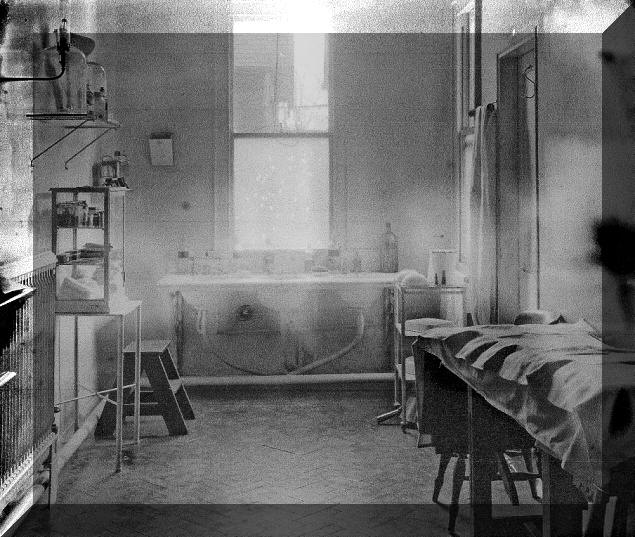 |
1931 to 1935 Mention is made of the economic crisis several times in 1931 and a reduction in expenditure was achieved by having three meetings with the AGM being held at the hospital. The summer meeting was held at the Hagley Bowling Green. Lionel Stretton was again President and now his son J W Stretton was one of two vice-presidents. At the March meeting the President announced the death of Dr de Blaquire one of the early members and by the year’s end Drs Wood and Watson Moore, a founder member, had departed. By contrast about nine new members were enrolled. Both Lionel Stretton and his son John were re-elected at the Annual General Meeting the latter as vice president. A number of cases were shown and the meeting declined an offer of a lecture on medical hydrology. The economic crisis was evident again in 1932. The usual format for meetings continued and in addition Dr Metcalf lectured on the relationship between gastric ulcers and cancer at the March meeting. The AGM was again held at the hospital and Lionel Stretton gave a talk on the relationship between the Panel, doctors and the Approved Societies. He was again elected president for 1933. Prophylactic injections against influenza were discussed at the December meeting and were to be continued the following year. It is unlikely that they could have been effective since viruses could not be cultured at that time. The first meeting of 1933 on May 5th followed the usual pattern but a number of practitioners produced surgical specimens and this was followed by a talk on “Law and the Professional” by Dr Eady. Major Webb had invited the Society to Springrove. Lionel Stretton gave a talk entitled “Humours of the Medical Profession” There was rain but tea was taken on the lawn. Lionel remained president after the AGM. Both Strettons presented cases at the December meeting and for the first time post mortem findings were described by Dr Porter.
|
|
1934 started with an emergency meeting to discuss rule 3 of the Kidderminster Hospital Contributory Scheme which would require members of the scheme to obtain permission before having non emergency treatment elsewhere. The Hospital was clearly under financial pressure and the President was asked to send an explanatory letter pointing this out. The Summer Meeting was on Brinton’s recreational grounds on the Spennels where the Mayor Mr G Woodward invited members to tea. Dr. Luring (later physician to the hospital) was present at the December meeting when only four others attended. Dr Evans a founder member died in early 1935 and the usual condolences were forwarded to his widow. He was of the generation who practised as physician and surgeon. The summer meeting on May 22nd was shared with the Worcester Panel Committee and the party was welcomed by a director of Cadburys. At the AGM in October JL Stretton referred in his speech to a visit made to German Hospitals – alas no details are given. Dr Luring joined the society. In December Dr MacArthur asked for advice on fees for lady members of the Independent Order of Oddfellows. It was assessed as 11 shillings. 1936 to 1940 Activities were limited in 1936 and the AGM, with the Annual Dinner was held at the Infirmary. The format was as before with case presentations and occasional talks. After being elected President yet again JL Stretton mentioned the death of Dr Smeeton Johnson. Matron was thanked for her hospitality. Activity was much reduced in 1937 for reasons unknown. The death of Dr H L Miles a founder member was noted at the AGM which was again held at the hospital There was a Clinical meeting in December at which Dr Nairac amongst others was proposed for membership. |
|
|
|
The running of the society had obviously been disrupted and the minutes for 1938 were signed in 1942 by Dr Dykes. In addition there are no minutes from 1939 to 1942. Illness of the President or the National Emergency may have been to blame. There were six meetings that year. The text of the April meeting entitled “The Clinical application of Sex Hormones” by Dr J Stanley White was attached to the minutes. We are approaching the modern world. The summer meeting was held at Dudley zoo. 12 members and 30 visitors attended and heard a short address by the President. At the December meeting the modern world intrudes again with Dr Miles presenting two cases of meningococcal meningitis treated with Prontosil, an early sulphonamide, and the first successful antibacterial commercially available. From these minutes it would appear that no meeting occurred until 13th December 1942. On that, a Sunday, Dr Dykes presided over a meeting devoted to Medical Planning. The Secretary wrote that an AGM in 1939 had to be cancelled because of the outbreak of war - in marked contrast to 1914. A letter of resignation from Mr JL Stretton was read and a vote of thanks was sent to him. He had been President for 31 years and had barely missed a meeting. He had kept the Society going when numbers were small even if the format was limited. His son JW Stretton was elected President in his place. he remainder of the meeting was devoted to Medical Planning. This included working with BMA guidelines. A proposal from Dr Craig that ”Free choice of doctor is essential” was passed as was an amendment from Dr MacArthur “whenever possible”. Planning meetings were to be held monthly and all doctors in the district were to be informed of the programme. |
|
1943 found Mr J W Stretton as President as he was in the following year. Clinical meetings took place in April and June and planning meetings specifying requirements for the new NHS in April and May. American doctors from the hospital at Wolverley joined the Clinical meetings and made good contributions such as two cases of petrol burns. At the May meeting a list of the Society’s proposals for the NHS was drawn up. The approach was positive and supported the idea of Group Practice from Health Centres. Diaphragmatic hernia of the newborn was the subject presented by Mr Lawson from Dudley. At the AGM on 17th December the payment for speakers under the NHS White Paper was discussed. Further meetings with the American doctors were proposed. Mr JW Stretton was again President at the Clinical meeting on 17th March 1944. Twelve members and six Americans were present. It was decided that the President should change each year. Major Graves, probably an American neurosurgeon, gave a talk on “Subdural hygroma and operative technique” and a Mr Salingan “Multiple exostoses resulting in popliteal aneurysm”. Twelve members and an RAF officer attended the planning meeting on 6th April and discussed controlling bodies, agreeing that they should be responsible for all civilian health services. There was a subsequent meeting with Sir John Wardlow Milne KBE MP. At the AGM on 15th December a motion by JW Stretton proposing rotation of Presidents was carried. Dr Dykes was elected. There were only two meetings in 1945. Dr Walker showed three dermatological cases including cattle ringworm and a rodent ulcer. The AGM was held as usual in the hospital. Dr J Craig was to be the next President. |
|
|
The old hospital Library |
1946 to1950 On February 1946 a Clinical meeting at the Hospital heard of a hydatid cyst removed at operation, the treatment of atrial fibrillation with quinidine, and a notable lecture on Penicillin by John Stretton. He warned of its limited spectrum, its side effects and the danger of producing bacterial resistance. He seems to have known of penicillinase. The next meeting in March was addressed by Dr Shepherd of Barnsley Hall on ”Psychiatry and General Practice”. He stressed his availability twice weekly. A special meeting was called on October 4th to discuss a BMA circular threatening resignation if the Government failed to compromise on some points. The motion was carried by 19 votes to nil. At the AGM it was decided to buy the retiring matron of the Hospital, Mrs Stretton, a glass bowl. Dr Porter was elected President for 1947. The only minuted event in 1947 was the AGM and dinner at the Park Atwood hotel chosen perhaps because Mrs Stretton was no longer matron of the hospital. It was decided to form a sub-committee to bring the rules of the society up to date. Dr MacArthur was elected President for 1948. The National Health Act came into force on July 19th 1948. A meeting on Jan 2nd was given a very clear summary of the principal points by the President, Dr MacArthur. An extraordinary meeting was held in the hospital boardroom on February 20th for further discussion and letters were drafted to the two local newspapers explaining their remaining objections. It was stated that doctors had long wanted a public health system, and their stance in wishing to preserve freedom of choice was non-political. Money was not an issue. |
|
29 members signed the declaration which was to be displayed in all waiting rooms. There was a further meeting on April 23rd attended by 25 members and 11 visitors. A BMA question to the Minister was considered but was rejected by 11 votes to 10 with 7 abstentions. An eventful year ended at the AGM in the boardroom on 26th November. Dr MacArthur’s work during the preceding year was praised and deservedly so. Seven new members were enrolled and Dr Lawrence was elected President for 1949. After the events of 1948 only one meeting was minuted for 1949. Dr Robin Lawrence the eminent Specialist in Diabetes (and brother of the President) gave a lecture on his subject on June 17th to 24 members. No AGM is minuted for 1949, continuing a trend of the previous years. The AGM for 1946 for example was signed only in 1948! 1950, by contrast, commenced with an AGM probably from the previous year. Dr C Mackie became President and proposed a return of clinical meetings which had never been formally abandoned. There was a clinical meeting on February 23rd at which Dr Malins showed a case of thyrotoxicosis and Dr MacArthur, hypochromic anaemia. A special meeting on June 27th heard a lecture ”Some Prescriptions” by Prof. Melville Arnott and a further special meeting in July discussed the closure of Sunnyside Nursing Home. Two alternative private beds were offered at the Croft by the Hospital Management Committee. Dr Malins was to try to arrange 40 GP beds at Blakebrook. A further meeting on October saw a demonstration of acute pancreatitis by Dr Malins followed by a lecture on Midwifery by Professor Morris from Manchester. Two more clinical meetings and the summer meeting at Park Atwood preceded the AGM on 12th December in the board room. JW Stretton presented a case of pyloric stenosis following gastroenterostomy, and carcinomatosis of the breast relieved by ovariectomy. Dr Price was elected President for 1951 and a rise in subscription to 10 shillings decided. 1951 to 1956 From the beginning of 1951 the quality of the minutes deteriorated. They were abbreviated and often illegible. There was a meeting in March addressed by a Professor Stevens but the subject is unclear. April’s meeting consisted of case presentations by Drs Malins, Miles and Mr Stretton. Professor Pomfret Kilner of Oxford spoke about plastic surgery in June and Dr Strang gave a presentation on fenestration of the middle ear accompanied by a colour film in September. Although locally based speakers still gave presentations there were more outside lecturers, presumably NHS supported. At the AGM Dr Malins was elected President. At a meeting in April 1952 case presentations were followed by a meeting with the still new Hospital Management to discuss medical staffing. The Committee agreed to be generous! Bacterial endocarditis treated with penicillin and aureomycin was the subject of a presentation by Dr Malins and the RSO in March, and in April Mr JM Small from Birmingham discussed Neurosurgery. Whether the June lecture on ”Wind” by Dr Charles Baker was lighthearted is not stated. The Society again showed its interest in medical staffing at a special meeting in September. Mr Stretton's retirement was foreseen and it was proposed to advertise for a replacement. In addition Mr. Gibbins who was part-time was to have his hours increased and a part-time general surgeon with a teaching hospital commitment was desired. An Orthopaedic surgeon was needed. There was a case presentation by Dr Malins in October and a lecture by Dr Partridge of Guys Hospital on Depression. He reassured his audience that ECT was completely safe! The AGM was again delayed to the following year. The AGM for 1952 was held in January of 1953 and Dr Miles became President. An undated talk by Dr Brian Brookes on ulcerative colitis attracted an audience of 45 showing how the Society had grown in the preceding years. The remaining meetings consisted of case presentations, except for a presentation by the Medical Protection Society in October. Outside speakers were more evident in 1954. In February Mr Stanley Aylett lectured on carcinoma of the colon ‘with lantern slides’ And Dr Senter talked about acne (X-ray treatment not recommended!). Mr D’Abreu spoke on chest surgery and Dr Weiner on blood transfusion. There is no note of an AGM in 1954 but Dr Beatty was President and read a paper on asthma from a GP standpoint in January 1955 stressing psychological factors. The minutes for 1955 are brief but Mr Doran, newly arrived, discussed “Peptic Ulceration” for which surgery was deemed the best treatment! Dr Smallwood gave a talk on Rheumatic Fever in March noting its decline and Dr Starkie, the MOH, discussed BCG in April. An AGM was also held in April and Dr Aldridge elected President, the original practice of election for a specific year having been abandoned. A Sunday Meeting at Lea Castle Colony on May 8th demonstrates the change in outlook today. Cases of mental defect were shown, mongols , phenylketonuria, for which a curative diet was considered too expensive,and kernicterus. There was a talk on vomiting in infancy by Dr Aldridge in October and 100 cases of pyloric stenosis treated at Worcester were described. The year ended with a presentation by Mr Chalmers of Worcester of his experiences as an obstetrician in the Highlands and Islands. There were five meetings in 1956 and three with outside speakers featured plastic surgery, psychiatry and gynaecology. At the AGM Professor and Mrs Malins were thanked for providing their house for the summer meeting which was unfortunately not in the minutes. Tributes were paid to Miss Moody (Mrs Ball) who was retiring from the SHO Post at the December meeting. Dr Black then gave an erudite lecture, “Third Stage Haemorrhage”. The original leather bound minute was full, the last meeting mentioned being a talk on carcinoma of the bladder by a Mr Charles Nicholas and Dr JH Sheldon on “The Problems of Old Age” in February 1957. ”Anaesthesia and the Family Doctor” by Dr Clarke of Birmingham was the first meeting in the new book and was held in the hospital boardroom in May. Many General Practitioners gave anaesthetics at this time and Dr Clarke warned of the dangers on Nitrous Oxide which was widely used in anaesthesia for dental extractions. Drs John and Pamela Ball (nee Moody) were proposed for membership at the April meeting. A symposium on peptic ulcer by Drs Wadsworth, Mr Gibbins and Dr Thorne heard the current wisdom which now seems very outdated being pre-helicobacter. The AGM in May at Consterdyne heard that there was an annual deficit in the accounts because of late (or non) payment of subscriptions. Direct debits were advised. Mr Gibbins was elected President. At the November meeting it was decided not to read the minutes of the previous meeting in future. Mr Gibbins then talked about hydronephrosis including surgical treatment. A new surgeon Mr Chitty was proposed for membership in December. Dr Donald Teare the Home Office Pathologist gave a lecture which produced the biggest audience for years. 1958 began with a lecture on hypertension by Dr Thorne. His management was passive by modern standards mainly because of the lack of effective and non toxic drugs. There were two speakers at the March meeting. Dr Rogers a pathologist from the Children’s Hospital discussed antibiotic therapy and Dr Clifford Hawkins gave a talk on steroids which seems relevant today. April saw a brains trust featuring eminent local figures in medicine and administration. Questions included ‘Do we need Consultant Geriatricians?’ and ‘Are there too many Hospital Management Committees?’ How things change! Dr AM Wadsworth was elected President in May. Once again there was a budgetary deficit owing to non payment by members. Banker’s orders were again requested. Surprisingly it was decided to revive the reading of minutes at meetings. October saw a statement of regret for the death of Mr Chitty. Dr Ellis Jones described ”Research in General Practice with particular reference to Toxic Nephropathy”. A November meeting in the boardroom heard that the hospital Secretary had decided to charge two shillings and sixpence for coffee and biscuits, and Dr Clark gave a talk on pelvic tumours. Mr Tooms, replacing Mr Chitty and Dr Malins, presented cases in December. 1958 had been successful in attracting 10 new members and a good attendance but meetings were not on a regular basis. Meetings had to change venues from the Board room quite frequently. 1959 Child psychiatry and Himalayan mountain climbing accounted for January and February. In March the Group Secretary announced the abolition of the House Committee which met some opposition. Professor MacLaren discussed “The Speculum Past and Present”. He drew attention to the relative backwardness of cervical smear provision in this country vis a vis the U.S. Professor McKeown discussed hospital provision with regard to mixing of different specialties on one ward. Dr Starkie the MOH became President in May. Payments had improved and there was to be an annual dinner at Park Attwood which was still a hotel. The October meeting heard the refreshment charges were to be rescinded for which the group secretary was to be thanked. ”Somotypes and Clinical Prediction in Preventative Medicine” was the odd title of the meeting. The years end heard Mr William Gissane on Road Deaths. He noted the preponderance of males under 45 years, increasing speed and congestion. He called for centralisation of services – so nothing has changed! There was a demonstration of hypnosis in December. 1960 to 1970 The new decade commenced with the old format of a meeting in the hospital boardroom at which the society’s business was followed by an address by a local specialist. Dr Thorn described a tracheotomy by a house physician on a chronic bronchitic. Dr Starkie gave statistics that showed infant mortality to be higher in Kidderminster than in the adjacent towns. February’s meeting in 1960 heard that heart infarction had risen by 100% in 28 years which was attributed to fat in the diet, smoking etc. And a later meeting Mr d’Abreu talked about surgery for pulmonary carcinoma which could be curative. Mr Doran told the society in December that Mr John Stretton had pioneered nylon darn in hernia repair. The rapid changes in health provision brought proposals for a change to the constitution but progress was very slow over the next few years. Dr Buchanan was President in 1960 after the AGM. New members continued to arrive and monthly meetings were usually maintained. Things continued in the same vein in 1961. Local speakers were supplemented by well known visitors. Mr Doran was President. At the AGM in May constitutional changes were stymied. The annual dinner was again at Park Atwood and a talk by Mr John Charnley, then a celebrity, came to fruition on November 3rd. A lecture by Dr Tibbetts from Birmingham in December on depression omitted any mention of amitryptyline. So ended the year. 1962 started with a lecture on referred biliary pain by Mr Doran. There was a dinner at The Elms in February accompanied by a speech from a BMA official on the implications of British entry to the Common Market. Unfortunately there are no details. There were also talks by Professor Harding Rains on arterial surgery and on perinatal infections by Mr Logan Edwards. He quoted a case of pockmarks in a newborn whose mother had been a victim of smallpox showing that the virus had crossed the placental barrier. The AGM in May elected Dr Lamb President. An interesting talk in December on the use of LSD in treatment at Powick, where a special unit had opened, brought the years programme to its end. 1963 Clinical meetings were reduced to four. Dr McIlveen gave a lecture in February on specialised investigations in cardiorespiratory disease. He was attached to a unit performing complex cardiac operations in a former tuberculous hospital near Bromsgrove. Such things happened prior to audit. There was an annual dinner at the Swan Hotel in Stourport in March at which a Dr Patterson gave a talk on “Rheumatoid Arthritis in General Practice” stressing the diagnostic difficulties. In May Dr Thorn became President and invited members to a garden party at his home. Members were finding the hospital boardroom inadequate as a venue for meetings and various sites were proposed including Blakebrook, which was the old workhouse, now being turned into a hospital. There were three more meetings, the most interesting being in October on head injuries by Mr JF Porter from the Radcliffe infirmary. 50% of cases admitted were the result of road traffic accidents. Mr McKenzie’s talk on the surgical treatment of deafness opened the programme for 1964 in February. Members were able to look at a polystyrene tube in an ear drum. There was a meeting in the Outpatients Hall in March at which Dr Thorn discussed ECGs. A draft new constitution was presented to the AGM in May but appeared to contain a large number of errors and was referred back for improvement. Dr Lurring was elected President. There were three further Clinical meetings. In October Mr Gibbins presented two cases of partial hepatectomy, one for carcinoid, and both were alive after two years. Mr WG Smith from Birmingham gave a presentation entitled “Is your gynaecologist really necessary?” Monthly meetings were maintained in 1965. Professor Gilespie lectured on virus disease and Dr Malins gave a lecture on ”Diabetes” in April. At the AGM in May Dr Cruikshank became President. 73 members had paid their subscription but 11 had failed to pay. The number of members had increased at least twofold in 15 years. Dr Ball informed the Society that the General Practitioners Association had obtained permission to use the boardroom at Mill St as a Medical Centre. The Society emphasised its readiness to cooperate in arranging a committee with a view to building a Post Graduate Medical Centre. There were talks on “Infant Malformation” and” Advances in Chest Medicine” including defibrillation. Mr J Moss, Director of animal breeding at Avoncroft, finished the year with “Applied Genetics” 1966 saw the idea of a Postgraduate Centre forming clearly. One member, Dr Tibbetts, wrote to say he was leaving for Canada, not uncommon at that time. Amongst the more unusual cases presented at clinical meetings was pneumotosis cystoidis intestinalis which was cured by colectomy. A temporary building at Mill Street followed by a purpose built structure at Bewdley Road was envisaged and the AGM in May requested that the President write to Professor Whitfield, the Postgraduate Dean, for his support and advice as to whether the Society could meet in the new centre. By the October meeting a visit was being arranged to Dudley Road PGMC and Dr Paton was invited to visit Kidderminster and give advice. Two lectures warrant note. A Wing Commander Robertson from Oxford discussed hypertension again and mentioned renal angiograms. Mr Gurevitch a very well known figure in Midlands medicine lectured on “Paediatric Surgery” in December. The new Postgraduate Centre features prominently in 1967 and Mr Gibbins outlined plans at the AGM on May 5th. There were to be new temporary premises at Mill Street and the Regional hospital board had promised a building at Bewdley Road but money would have to be raised locally. The Appeals Committee consisted of Mr Gibbins, Mr James, Dr Campion, Dr Sheward and Dr Ball and a large sum was raised quickly. |
|
|
|
Technology was advancing and Dr MacNamara arranged for his talk on “Screening” to be relayed to the auditorium. Mr Roberts and Mr Sear accompanied their lecture on ”Dental Problems of Medical Interest” with colour slides. Dr Cronin was in the chair at the beginning of 1968. At a Clinical Meeting in March Mr Lalljee presented a case of posterior dislocation of the hip at rugby. Dr Paton from Dudley Road appeared in his medical guise to lecture on “Drugs and the Liver”. He mentioned the anaesthetic drug Halothane which was subsequently shown to cause liver damage. Numbers are not often noted but a special meeting called to discuss changes to the constitution in April 1968 was non quorate and nine members had to be found by telephone! At the AGM in May Dr Brotherton became President and attention was given to fundraising for the PGMC. Dr Simon spoke to the Society at Lea Castle and stated his aim to educate his charges to return to society. The uncertain topic of geriatrics was explained by Dr Cope of Selly Oak hospital in February 1969 and in March Mr MW Bond gave a talk on “An Approach to Breast Malignancy”. At the AGM in May Mr James became President. The annual subscription was raised by one pound because of costs of the PGMC. Mr Piggott from the Royal Orthopaedic hospital opened the series for 1970 with a lecture on “Spina Bifida” and Dr Popert a well known rheumatologist gave an account of the common arthritides. Dr Mackie became president at the AGM in May in an active year with the new centre approaching completion. Drs J Ball, G Campion and Mr Gibbins were elected trustees of the centre having been on the Appeals Committee where they raised a considerable sum of money. At the year’s end Mr CJ Fulford from the Birmingham Accident Hospital spoke about “Casualty Work” to a very large crowd. He had a poor view of junior doctors and their capacity for work. He described them as “Communistic young bastards”. His clinical presentation was also pithy and amusing. |
|
1971-1979 This year opened with the Postgraduate Centre almost complete. On February 12th 1971 the Secretary informed members that the next meeting might be held there. Dr Atkinson from Worcester gave a lecture ”Bleeding from the upper gastrointestinal tract”. He showed striking photographs taken through a gastroscope – a sign of things to come. The next meeting was in fact in the medical meeting room at Bewdley Road. Dr R Summers was elected General Practitioner Member of the new library subcommittee. There followed a lecture by Professor Rhodes of St Thomas’ hospital on “The place of the General Practitioner in the Hospital Obstetric Service”. He mentioned a GP hospital unit with which he was involved. The long awaited first meeting in the Postgraduate Centre took place on Friday 6th April, with Dr W Mackie in the chair. Two new members were elected to the library sub-committee, Dr Eeles and Dr Wilner. The President then emphasised to members that they should consider the Society’s future urgently and discuss it at the next AGM. As many as possible should attend that meeting. Dr Eeles then gave a talk on “The Pattern of Road Traffic Injuries”. The AGM took place on Friday May 14th 1971. There was a positive bank balance of £77-29 and it was decided to give £50 to the floating fund of the Postgraduate Centre Executive Committee. Mr K Forsyth was elected President with Dr John Ball as vice-president. A Medical Society Social club had been formed to enable a bar licence to be obtained for the centre and it was decided that the President should be an ex-officio member of the club committee. From this point onwards regular postgraduate meetings, organised by the Postgraduate Tutor, were held at the Postgraduate Centre as part of the government programme for continuing medical education. Those attending were rewarded and the lecture fees were borne by the state through the postgraduate organisation. The Society had therefore lost much of its purpose. As a consequence discussion of its future then took place. There was a strong desire to keep it in existence as an independent entity. Dr Ball proposed about four meetings per annum, the dates and format being at the Presidents discretion. It was also decided that junior hospital staff should be exempt charges for membership of the Centre and pay a nominal sum of 25p for membership of the social club. The next minuted meeting was on February24th 1972. It continued the old format with society business followed by a lecture from Mr McKenzie on “The Larynx: Diagnosis and Disease”. The President pointed to the decline in attendance (there were weekly lectures in the PGMC) and suggested a further emergency meeting which was agreed. It seems not to have come to fruition for the next meeting was in the old mould with an impressive lecture on prostate cancer by Mr MacDougall from Wolverhampton. |
|
|
At the next AGM in June which was barely quorate the situation was addressed. Dr J Ball’s suggestion that the Medical Society cease its clinical and allied activities until the next AGM was accepted. The President elected for the next year was Dr Ball. He said that he proposed to act as a caretaker to the Society and not as an undertaker and would rely on the help of members. He asked for suggestions and a dinner or dinner dance was mentioned. This took place at the Briars Hotel in November. It was a success in every respect, there being one hundred and six present to hear Dr Michael O’Donnell on “Looking Sideways at Medical Journalism”. On May 2nd 1973 there was a trip to see ‘Romeo and Juliet’ at Stratford. The AGM followed on May 8th. Dr Ball the retiring President reported on a successful year but he expressed his concern for the Society’s future. He felt this had to be mainly of a non clinical nature with participation by other professionals. Dr Brotherton opposed any contact with social services! Dr Macnamara was elected President and proposed an active social programme. |
|
|
The old hospital about 1890 |
The AGM on 5th July 1974 was informed of a number of new members but social events had been poorly attended. Dr Macnamara wondered if the economy was to blame. Dr Campion was elected President with a brief to carry forward a social programme and there were two successful events in that year, a dinner at Hartlebury Castle and a garden party at Dr Campion’s house. His swimming pool proved a great attraction. Attempts were being made to attract other professionals to events. The AGM on 2nd July 1975 was told that a number of changes had to be made to the rules of the Society because of recent alterations in the law. The rules of the Kidderminster Medical Society Social Club had also to be changed as a result of a letter from the West Mercia Constabulary relating to bar opening times. Dr Campion was congratulated for his efforts to resuscitate the Society during the preceding year and Mr McKenzie became the President. A successful dinner at Stone Manor with an address by Sir Michael Davies QC a high court judge was held on September 1975 and there were two visits to the Royal Stuart Crystal Factory in 1976. |
|
The Society was adapting to its new status. Another factor favouring meetings in this era was the readiness of pharmaceutical firms to provide refreshments. Dr P Dutton was elected President on 19th July 1976. A visit to Brinton’s carpet factory, then in its heyday, took place in September and this was followed by a dinner in December with a speech by Dr Paul Massey on the Olympic Games . In May 1977 the President arranged a musical evening at Hartlebury Castle which was very well attended. The AGM on June 13th 1977 may have had a self congratulatory air. The PGMC had been a great success, some meetings were overfull and an extension was proposed by the executive committee. After considerable discussion the President proposed that the Postgraduate Appeals Committee be reconstituted, the members being Mr Gibbins, Dr Ball, Dr Campion, Dr Wilcox, and Dr Murray, the Clinical Tutor. The proposal was passed. Dr Simon was elected President and said he hoped to organise three events in the forthcoming year. Several members expressed doubts as to the Society’s future but a majority view was that it served to bring the medical profession together in its present form. As part of the new remit a clinical meeting was held under the Society’s auspices at the PGMC on 15th September to which members of the dental and veterinary professions were invited. Dr Chaudoir was in the chair and the speaker Mr Aitken the Regional Veterinary Officer. His subject was “Rabies”. After an historical account he showed a film ’Le nouveau Visage de la Rage’. A dinner was held at Stone Manor on December 9th followed by an address of a lighthearted nature by Sir William Trethowan, Professor of Psychiatry at Birmingham University. He concentrated mainly on medical reassurance. As part of the remit to broaden the range of subjects Dr Jacks from Bromsgrove gave a talk on “Homeopathy” on January 23rd 1978 at the PGMC. Sensing less than total conviction amongst his audience he finished with the words” If you don’t believe it try it”. On April 24th a Ministry veterinary officer Mr Shaw, gave a talk to about 50 people on “Zoonoses”, that is animal diseases which can be transmitted to humans. He was critical of many modern farming practises including antibiotic misuse and the spreading of slurry on fields. In May the Society was invited to Edge View in Kinver where there was a tour of this unit for people with learning difficulties. The AGM took place on June 29th with 29 people present - it was never well attended. There was satisfaction with the year’s programme and there being a small surplus in the accounts £25 was donated to the Royal Medical Benevolent Fund and £100 to the PGMC fund. |
|
|
After Dr Ruth Lillie had been elected President the discussion centred on the Society’s future once again. There was a majority which felt that the Society had been a sponsor of the PGMC (with some dissent) and that they should amalgamate. A resolution ‘that the Kidderminster Medical Society and the PGMC liase to produce a constitution amalgamating both bodies, the proposal to be presented at an Extraordinary General Meeting in November 1978’. There was a successful buffet dance at Stone Manor Hotel on November 24th and on 27th a lecture at the PGMC by Mr Kirby a Consultant Dental Surgeon from Dudley Rd Hospital. He warned about the effect of Polo mints on teeth illustrated by slides of rotting incisors. A Special meeting to discuss amalgamation of the PGMC and the Society took place on January 16th. It was agreed to have the proposals examined by experts and brought to the AGM. A very successful evening lecture under the Society’s aegis by Professor Burkitt of lymphoma fame occurred on 12th February 1978. He made a convincing and very amusing case for the importance of dietary fibre, and showed photographs of stools from various countries with his ‘penetrometer’ which estimated their malleability. There was a bowling evening in March 1979 and a clinical meeting by Dr Preston who had taken part in the development of Concorde. His fascinating survey included decompression, and cosmic radiation. On July 5th 47 members went to Ludlow to see ‘Loves labour Lost’ by the bard of Avon. There was a picnic en route on Clee Hill. Seven days later the AGM was held at the PGMC and the proposals for amalgamation were passed unanimously. Election of officers proceeded under the revised rules. Mr Gillison became President. 1980 – 2000 From this point the programme of the PGMC became that of the Society. It would be superfluous to list each Postgraduate meeting held at weekly intervals in term time over the ensuing years and only those specific to the Society and important milestones will be mentioned. Mr Gillison held an evening at his house on 20th June 1980 which 60 people attended. There was a disco in the garage for younger members. An open meeting on June 30th heard Dr Lloyd Davies from Abergavenny a GP and conductor of the Gwent Bach choir talk on “Medicine and the Musician”. At the AGM on September 11th there was further discussion and a number of corrections were suggested. Eventually a motion by Dr Wilcox ‘that the new constitution be ratified subject to any amendments by the working party, whose amendments will be presented at the next AGM’. The AGM was followed by a short film on mountain rescue. The annual bowling evening at Titton on 19th November was won by the consultant team. The new decennium found the Society in full flow. It was nominally in charge of the Postgraduate Education Programme, was running its programme of more general lectures and maintained an active social calendar drawing together medical consultants, General Practitioners and other professionals. 1981 saw a dinner dance at Stone Manor in March attended by 70 members and companions. The AGM was held on 2nd October. The changes to the constitution were again considered and the President expressed reservations about paragraph 2b which, in his view, gave the Executive Committee of the PGMC a right to veto a presidents wishes. After much discussion it was agreed that the President should be co-opted on to the Committee for his year of office. Dr Murray was elected for the following year. The meeting was followed by a buffet enjoyed by the 80 members present. The AGM was held on October 7th. All seemed well apart from non payment of subscriptions by some members. Problems resulted from the amalgamation of the PGMC and the Medical Society. In addition to the series of postgraduate meetings organised by the Clinical Tutor there had been a successful dinner dance at Stone Manor, a visit to Shakespeare at Ludlow and a weekend trip to Paris. Dr Wilcox became President for 1983. An interesting talk, “Ironbridge: Birthplace of the Industrial Revolution “ was given by Mr Cussons, the curator of the Ironbridge Museum. He mentioned the part played by Quakers such as Abraham Darby and immigrants from the continent in its development. March 23rd 1983 saw another successful open meeting organised by the Society. A veterinary surgeon Mr P Watson gave a lecture entitled “The approaching plague –Hydatid Disease” He maintained that nearly all sheep carcases were infected. The 93rd AGM was held on October 6th 1983.There were 23 members present. Because there had been problems in filling the post of President it was proposed that the officers of the Society have the right to ask any member of the Society who had not filled the presidential office to undertake the post. A sum of £600 had been raised in commemoration of Dr Pauli. A cheque of this value was presented to his widow. Dr Murray was proposed as member of the PGMC Appeals Committee. Dr Parker became President for 1984. There was an open meeting on April 3rd. Mr Bryson a medical photographer gave a talk on “The History of Acromegaly and Gigantism”. 17 members attended the AGM on 18th October 1984. In addition to Mr Bryson’s talk already mentioned there had been a visit to ‘A Midsummer nights dream’ at Ludlow and a successful dinner dance at Stone Manor. The accounts of the PGMC and Society had been amalgamated resulting in a generous balance of £18000. The concept of using the sum to enlarge the centre was aired but not put to a vote. Dr J Williams was elected President for 1985. The Society meeting on December 7th 1984 heard a talk entitled “An arm and a leg and who lost what at Waterloo” by Mr BEF James. He mentioned many fascinating anecdotes and used as sound effects the roar of the cannon used in the battle. The first Society meeting for 1985 7th February was ‘Don’t put your daughter on the stage Mrs Worthington’ by Mr John Doyle, Director of the Swan Theatre in Worcester. He gave an insight into events backstage and described the problems of running an experimental theatre in Perthshire. The AGM took place on October 10th. The finances of both the Society and the PGMC were sound – both were still dealt with separately. Dr Eeles requested a projector with TV monitor and was asked to submit a quotation to the Committee. The PGMC was looking grubby and the District Health Authority was to be asked to deal with the matter. There had been a successful social programme, a dinner at Hartlebury and a garden party at the President’s residence. A trip to the Swan theatre had unfortunately been a flop. Dr Eeles was elected President for 1986. |
|
|
A last open meeting for 1985 was held on December 3rd. Dr Brian Evers the former coroner gave an account of his experiences as a prisoner of war. The AGM of 1986 was held on October 14th. There had been a dinner Dance at Hartlebury and a Garden party at the Presidents house. The PGMC had been redecorated and finances were sound. A further member, Mr Gillison was elected to the Executive Committee. It appeared that evening meetings were to be abandoned in term time. Dr Jethwa was to be President for 1987. The first open evening meeting of 1987 was “The Aging Athlete” given by Mr Austin a former Olympic athlete and coach. He advised continual activity! A further meeting on May 20th heard Dr Delamere, a physician, discuss “Everest –no place to be ill”. A member of his expedition had suffered a myocardial infarction at high altitude. The AGM was held on October 7th. One major item was the provision of alcohol at PGMC mid day meetings. It was pointed out that doctors should set an example in alcohol use. A ballot of members at lunchtime meetings was in favour of alcohol provision. There had been a successful dinner at Spring Grove House but two other proposed events had to be cancelled for lack of support. The subscription was to be raised to £15 per annum of which £3 was to go to the society. Dr Herbert was elected President for 1988. There was still time in 1987 for a Society evening lecture which seems to have had the title “Babies, Baths and Boobs” By Dr Close. He compared rates of breast feeding in England and a West Indian island. They were almost reciprocal there being 85% breast feeding in the West Indian island and 79 % bottle feeding in England. The following AGM on13th October 1988 was informed of a successful Dinner at Springrove House. The annual cricket match between General Practitioners and Consultants had been a draw. It was decided to call it the John Russell match in honour of a former wicketkeeper and GP. A cup was to be purchased for the event. |
|
|
|
Throughout these years the number of members had risen considerably and the society had a substantial reserve of funds by past standards of several hundred pounds. The PGMC committee controlled greater funds, the Bar and catering being profitable. At the 1989 AGM the sum available to the PGMC was over £28,000 which was invested in safe securities. This brought up the question of use. As the meetings at the Postgraduate Centre on Mondays were often overcrowded and noise from the dining area was an irritant to those in the lecture hall it was decided to extend the centre again if possible. Dr R Summers was elected President for the year 1990. He chaired a meeting on 17th September to discuss extension of the centre. A ballot of members had shown a majority in favour of the project. Mr Gillison the Clinical Tutor presented some plans drawn up by the Estates department which did not suit those present. A simpler solution costing about £250,000 was favoured. Raising the money would be a problem and a fund raising company was suggested by Mr Gibbins. Prior to this a fund raising committee was to be formed.
The AGM for 1990 heard more of the planned extension. There were two plans both requiring the building of a second floor over the existing structure. Both would cost over £600,000 one of them £800,000 in total. Fears were expressed of the approaching recession. At this point Mr D Bradley was elected president and took the chair. The impending 100th anniversary of the Society was raised by Dr Black. 1990 ended with a fascinating lecture on the Geology of Kidderminster by Mr Dick Warner.
|
|
The 98th AGM on October 22ndcontinued with consideration of the 100th centenary celebrations. Dr Wilcox proposed a committee and this was formed. Mr Gillison had obtained an alternative plan for the extension of the centre from Mr Clist, the original architect, which would cost £325,000. Once again there were reservations about the cost. An Emergency General Meeting to acquaint all members with the state of play was agreed. The Society had experienced a successful year with a visit to Astley vineyard amongst other items. Nine new members were elected – an exceptional figure. Dr Wilner was elected President for 1992 and said he proposed to have an after dinner speech by Mr Michael Fish a well known weather forecaster, in addition to the usual events that year. 1991 ended with a talk on the history of Kidderminster by Mrs Betty Parr who had browsed through ‘Berrows Journal’ a newspaper dating from 1710 with special reference to odd medical stories. The aforementioned Michael Fish event took place on 31st January 1992 with an enthusiastic audience of over 100. Humphry Lyttleton was the Speaker at the Annual Dinner and added a final flourish with his trumpet! The 99th AGM on 13th May was attended by 20 members. Dr Wilcox outlined the preparations for the centenary celebrations. Dr Black had prepared a logo which was accepted by the meeting. Mr Gillison described proposals to obtain four or seven year covenants from members towards the PGMC extension. Faced with some doubts amongst the audience he said he planned to contact members individually on their views. Other sources of money were to be investigated. Mr Da Costa was elected president for 1993. The meeting was informed by Mr Gibbins that he was validating a bust which he took to be of Samuel Stretton. This was subsequently installed in the PGMC. Mr L Gunaratne, a former surgical Registrar, had requested support for buying medical journals in Sri Lanka. £100 was donated. The year 1993 commenced with a talk about smuggling with, medical undertones The Centenary meeting was held at 28 Church Street, now Weston's Solicitors, there being 31 members present. Mr Gillison brought members up to date on the PGMC extension. 62 GPs and Dentists were prepared to covenant and 28 Consultants likewise making up 80% of the membership. The PGMC Committee had suggested that doctors who attended lectures whilst non members should be charged. The Clinical Tutor Dr Mantle proposed a change in the Constitution to allow for associate membership and this was carried. Dr Taylor was elected president for 1993/4. Dr J Parker proposed that £400 be sent to a former member Dr Phyllis Oxborrow for books at her missionary station. A Centenary Celebration Week on October 25th, 26th and 28th comprised a talk by Sir Richard Bayliss on thyroid disease, an evening meeting on “Medicine around Kidderminster” mainly concerning the Stretton family, and a dinner at the Gainsborough Hotel followed by a talk from Sir Michael Drury and a dance. Mr Henry Sandon gave an unstoppable talk on porcelain at the Annual Dinner at Spring Grove House to over 130 members and guests. The 101st AGM heard that the question of associate membership had become redundant. The appeal for the extension was advancing. One adverse fact was that Sir Michael Brinton was unable to become patron until 1995 because he was already chairman of the hospital CT scanner appeal. Dr Janet Adams was elected President for 1995. She declared it a Challenge Year. A further £200 was donated to Dr Phyllis Oxborrow making up the £400 originally requested. Discussion then ensued on the proposed extension of the PGMC. Mr Gillison mentioned the possibility of using the Pharmacy building once the pharmacy had moved in to the new hospital building. It appeared that the hospital Trust was not enthusiastic especially if financial support was required. Dr Mantle pointed out that many centres were now multidisciplinary which might change the Trust’s outlook. Drs Campion and Ball supported this concept. An extraordinary General meeting was to be arranged for further discussion. As regards social activities Dr Mike Stroud gave an illustrated talk on his journeys to both the poles and Col. Blashford-Snell was guest speaker at the Annual dinner. Both were very successful. A jazz evening INTENDED to interest the junior doctors had to be cancelled for lack of support.
|
|
|
The Society
Website was set up and managed by Dr Barrie Davies
|
At the AGM on 25th October 1996 Dr Davies reviewed his year as President. Mr John Robinson, warden of Wyre Forest had given a most interesting account of that rural treasure. There had been a fascinating talk on international trauma teams. The Annual Dinner was enlivened by the after dinner speaker David Gunson, an air traffic controller. A wet day at Bewdley tennis club and a presentation on mountain rescue by John Frankland were all successful and well attended. Once more the PGMC extension was discussed at length by members who had no idea of its imminent fate. A multidisciplinary solution was favoured and a motion from Dr Ball on those lines was put to the meeting and passed. Formal minutes cease at this point and are replaced by Newsletters which had already been produced by Dr Graham Wilcox and Dr Barrie Davies for some time. Dr S Booth was the president of the Society in 1997. It was a successful year with a garden party at his Blakebrook home and an Annual Dinner at which Dr Phil Hammond known for “Struck Off and Die” in TV, and a contributor to ‘Private Eye’, was the guest speaker. |
|
Quite suddenly the environment changed. In October 1997 the Worcestershire Health Authority produced a Strategic Framework Document with several options each of which meant the end of the Kidderminster General Hospital as such. The Society opposed these options virtually unanimously citing the integration of general and hospital medicine which was so evident in Kidderminster. Mention was made frequently of the financial stringency imposed by the financing of the new Worcester Hospital by PFI which had resulted in a huge increase in costs to Kidderminster’s detriment. Dr Booth’s valedictory address referred to a good year for the Society overshadowed by the authority’s plans. Dr Smith was President for 1997. The Annual Dinner was held at Stourport Manor. Dr Smith thanked Dr Richard Taylor for his campaign to save the hospital which brought loud applause. Mr Don McLean gave an amusing speech ‘devoid of smut’. The year saw much social activity there being trips to the Symphony Hall, the caves at Wolverley, to the ski slope at Gloucester and wine tasting at Harvington Hall. Dr Martin Lewis was president for 1998. He warned of the problems facing the Society. In this he was joined by the newsletter editor Dr Wilcox who pointed out that there would be no consultants based on site once the authority’s plans had been implemented. Nonetheless a full social programme was maintained including healthy walks on the Long Mynd and Wyre Forest plus a concert of the Kidderminster Choral Society which included Mozart’s Requiem. Mr Tim Curtis a Worcestershire cricketer who gave the after dinner speech at Spring Grove had played with famous figures such as Graeme Hick and Ian Botham. Dr Tim Wadsworth became President for 1999/2000. He warned of the troubles facing the Society and stressed the part it played in bringing the medical profession together. He foresaw a return to the way things had been 40 years ago as consultants became visitors to the hospital. At the AGM it was decided to exert as much pressure to save the Postgraduate Centre which had been originally sponsored by the Society. social activities continued to be successful and included a concert performance of the Barber of Seville at the Birmingham Symphony Hall. In 2000 it became evident that the Worcestershire Acute Hospitals Trust was going to demolish the Postgraduate Centre despite all the protests. Several meetings were held by the Society and the GPA. The Health Authority finally offered part of a closed ward which would be converted to a multidisciplinary postgraduate education centre. In the meantime the Society continued its social functions with numbers further increased by consultants who did outpatient clinics in the ADC. Thus in 2000 there was Music from the Towers at Stone Cottage and a visit to the Bodenham Arboretum plus the Annual Dinner. In 2001 a most impressive talk was given by Flt Lt Peters who had been harshly treated when captured in Iraq when his Tornado was shot down. Later there was a wine tasting at the Horse and Jockey in Far Forest, now alas closed. The Annual Dinner was followed by a Ball. Dr Taylor now the MP and fighting to retain something of the hospital was greeted with much applause. Dr Summers handed the Presidency to Dr Richard Davies for 2002. The Annual Dinner was enhanced by a demonstration of Pol Roger champagne including the Cuvee Winston Churchill. Jan Meggy our Consultant Gynaecologist was President for 2003. A midsummer barbecue at the family mansion overlooking Bewdley and a Brecon weekend preceded the Annual Dinner at Spring Grove where Conjurors entertained a large crowd. The last AGM to be held in the PGMC took place in October 2003. Despite the solemnity of the occasion only 15 attended. They heard a presentation on the new treatment centre from Dr Prince. Dr David Malcomson took over from Jan Meggy as President and saw the first meeting of the Society in the further education centre. Michael Wilkes showed pictures he had taken of Worcestershire wild life including some remarkable shots of gaudy male pheasants. Dr P Newrick gave the inaugural lecture on Diabetes. He mentioned the distinguished history of the Society and the part it played in the close cooperation between primary and secondary care and hoped that the new centre would maintain it. As mentioned much earlier the meetings were limited to up to five per annum and most information came from the newsletters. This has enabled the Society to fulfil what is now its principal function of keeping the General Practitioners and Consultants together. Mr Chris Gait was President in 2005 and had a successful year until he forgot the next (2006) AGM. There had been a towpath ride to Birmingham, a walk in the woods, and a visit to Avoncraft amongst others, plus an Annual Dinner at Spring Grove Park. |
|
|
Mr Paul Glossop was President for 2006. Important decisions had been taken to use the sums of money accumulated by the Society and supervised by the Trustees. Two annual bursaries were to be created, the first at Birmingham University and the other to be granted by the Trustees. In addition a teaching room was to be named after the Society ensuring that it will not be forgotten. The bursary contributions continue and are of great value to those pursuing a second degree who are not eligible for a grant. A Dinner at Spring Grove, two months before it burned down, was a great success. Dr Richard Horton took up the Presidency in 2007 and the Society has continued to draw the local doctors together through social activities, a function which has been particularly valuable at this time of rapid change. There has been an alternation between General Practitioners and Consultants as President, namely Dr Umesh Udeshi, Dr Gary Parsons and Dr Alan Bennett, the latter in 2011. In addition the bursaries granted to undergraduates continue the link with medical education. Long may it continue! |
'Dr John Wall' guided walk 2011 |
|
|
The
Author, |
